Oh heck yes, you have arrived at Week 4! If you don’t often stop to take stock of what you’ve accomplished, now is the time to give yourself a pat on the back for staying committed and continuing to show up and take action. You’ve achieved more than a lot of people ever will, because it’s one thing to wish for change and quite another thing to make it happen. I know the big sexy payoff moments are exciting, but if you can recognize the subtle—but powerful—shifts you’re making, that’s huge, too.
You have so many new tools and experiences in your toolbox going into this last week of the Core 4 program. Remember to dip into the resources to keep shaping your nourishing food plan, workouts, restful moments, and mindset. Finish out this month strong!
Week 4 Shopping List
Bacon (8 ounces plus 4 slices)
Cheddar cheese, shredded full-fat (10 ounces), optional
Chicken breast (1 pound)
Chicken sausage, any flavor (1 pound)
Eggs (19)
Ground beef (3½ pounds)
Pork breakfast sausage (12 ounces)
Salmon (1½ pounds)
Sirloin steak (1 pound)
Avocados (4)
Bananas (3)
Basil leaves, fresh (3 cups)
Blueberries (1 pint)
Broccoli (1 pound)
Carrot (1)
Cauliflower (4 pounds)
Cherry tomatoes (1 pint)
Cilantro, fresh (1 bunch) + Cilantro, fresh (1 bunch), optional
Cucumber (1)
Fingerling potatoes (12 ounces)
Garlic (8 cloves)
Ginger, fresh (1 inch)
Green beans (8 ounces)
Green leaf lettuce (1 head)
Green onions (3)
Jicama (1)
Kale (4 bunches)
Lemons (2)
Limes (8 to 9)
Mint, fresh (1 bunch)
Napa cabbage (1)
Parsley, fresh (1 bunch)
Poblano pepper (1)
Red bell pepper (1)
Red cabbage (1)
Roma tomatoes (3 plus 2 pounds)
Shallot (1)
Spinach (1 8-ounce bag)
Sweet onion (1)
Sweet potatoes (3 plus 2 pounds)
Swiss chard (1 bunch)
Thyme, fresh (4 to 6 sprigs)
Yukon gold potatoes (1 pound)
Almond milk (1¼ cup plus 1 tablespoon)
Almonds, chopped (¼ cup)
Ancho chili powder (3 teaspoons)
Avocado oil mayonnaise (¼ cup)
Balsamic vinegar (⅓ cup)
Black olives, sliced (¼ cup)
Chia seeds (2 tablespoons)
Chicken broth, low-sodium (1 cup)
Chipotle pepper, ground (¼ teaspoon)
Cinnamon, ground (2 teaspoons)
Coconut aminos (4 teaspoons)
Coconut milk (16 ounces)
Coconut, shredded and unsweetened (1 cup)
Collagen powder (2 tablespoons), optional
Cumin, ground (½ teaspoon)
Currants, dried, or raisins (2 tablespoons)
Dark sesame oil (1 teaspoon)
Extra-virgin olive oil or ghee
Fish sauce (¾ teaspoon)
Flaxseed, ground (½ cup)
Garlic powder (¾ teaspoons)
Harissa sauce, mild (2 tablespoons)
Hemp hearts (2 tablespoons)
Medjool dates (2)
Onion powder (½ teaspoon)
Oregano, dried (¼ teaspoon)
Parsley, dried (½ teaspoon)
Pickled jalapeño rings (1 tablespoon), optional
Pine nuts (¼ cup)
Pistachios, shelled (½ cup)
Rice noodles (1 8-ounce package)
Rice wine vinegar (2 teaspoons)
Salt and pepper
Smoked paprika (½ teaspoon)
Taco seasoning (2 tablespoons)
Tahini (1 tablespoon)
Tart cherries, dried (½ cup)
Thyme, dried (¼ teaspoon)
Tortilla chips, grain-free (6 ounces)
Vanilla extract (3 teaspoons)
DAY 21
For this day’s breakfast, lunch, and dinner eat leftovers from the previous week.
Meals to prep:
» Sweet Potato Breakfast Bowls
» Roasted Tomato and Garlic Soup
» Fresh Spring Roll Salad with Ginger-Lime Dressing, dressing stored on the side
» Pesto Salmon Sheet Tray Bake
Other prep:
» 1 bunch swiss chard, steam
» 2 pounds cauliflower, roast
DAY 22
BREAKFAST: Sweet Potato Breakfast Bowls + steamed swiss chard
LUNCH: Fresh Spring Roll Salad with Ginger-Lime Dressing
DINNER: Pesto Salmon Sheet Tray Bake + Roasted Tomato and Garlic Soup
DAY 23
BREAKFAST: Sweet Potato Breakfast Bowls + roasted cauliflower
LUNCH: Pesto Salmon Sheet Tray Bake + Roasted Tomato and Garlic Soup
DINNER: Fresh Spring Roll Salad with Ginger-Lime Dressing
DAY 24
BREAKFAST: Sweet Potato Breakfast Bowls + steamed swiss chard
LUNCH: Fresh Spring Roll Salad with Ginger-Lime Dressing
DINNER: Pesto Salmon Sheet Tray Bake + roasted cauliflower
DAY 25
BREAKFAST: Savory Ham and Egg Cups + steamed swiss chard
LUNCH: Roasted Tomato and Garlic Soup + roasted cauliflower
DINNER: Loaded Taco Beef Nachos with Avocado Crema (prepare today)
Meals to prep:
» Sautéed Kale with Balsamic Cherries
» Loaded Taco Beef Nachos with Avocado Crema
Other prep:
» 1 8-ounce bag fresh spinach, steam
» 1 pound chicken sausage, cook
DAY 26
BREAKFAST: Breakfast Sausage Casserole + steamed spinach
LUNCH: Chicken sausage + Sautéed Kale with Balsamic Cherries
DINNER: Loaded Taco Beef Nachos with Avocado Crema
DAY 27
BREAKFAST: Breakfast Sausage Casserole + steamed spinach
LUNCH: Loaded Taco Beef Nachos with Avocado Crema
DINNER: Chicken sausage + Sautéed Kale with Balsamic Cherries
DAY 28
For this day’s breakfast, lunch, and dinner, eat leftovers from the previous week.
Meals to prep:
» Mini Meatloaf Sheet Tray Bake
» Steak Cobb Salad with Southwestern Ranch Dressing, dressing stored on the side
Other prep:
» 2 bunches kale, steam
DAY 29
BREAKFAST: Banana Cinnamon No-Oatmeal + steamed kale
LUNCH: Steak Cobb Salad with Southwestern Ranch Dressing
DINNER: Mini Meatloaf Sheet Tray Bake + The Best Cauliflower Ever
DAY 30
BREAKFAST: Banana Cinnamon No-Oatmeal + steamed kale
LUNCH: Steak Cobb Salad with Southwestern Ranch Dressing
DINNER: Mini Meatloaf Sheet Tray Bake + The Best Cauliflower Ever
DAY 22: THE 90-30 WORKFLOW
Earlier in the program, on Day 14, you learned about how humans aren’t machines: our energy needs replenishing throughout the day. Inside your daily circadian rhythm, you have the shorter ultradian rhythm. If you’ve ever struggled to push through a long workday and stay highly motivated, focused, and attentive all the way through, you’re not alone. And if you multitask all day only to wind up feeling like you’re exhausted but like you accomplished nothing, you’re not alone either.
These two methods of working aren’t just common—they’re often baked right into workplace culture. A friend of mine started a job at a biotech company and was dismayed that though the workday ended at 5:00 p.m., his coworkers were all anxious to take advantage of overtime hours. It was an unwritten expectation that, as a team player, he stay longer. (And longer. And longer.)
Even if you work from home or have more flexibility in your schedule, how often do you take breaks? During your breaks, do you engage in activities that leave you recharged? And if your workplace culture or the shifts you work don’t allow for frequent breaks, do you make the most out of the time you do get?
Contrary to popular belief, pushing through very long blocks of work time doesn’t result in higher productivity. The opposite is true. And more surprising, even very short—but meaningful—breaks can leave you feeling refreshed, energized, and ready to focus again.
Implementing the 90-30 Workflow
In order to get more frequent, renewing breaks in my day, I adopted the 90-30 workflow, which I detailed in the Pillar 3 chapter. If you’ll recall, the idea is that for every 90 minutes of focused work time, you take a 30-minute renewal break.
The 30-minute break can be something active or passive, such as eating a meal, walking, reading a book, exercising, or meditating. The key is to avoid habits that further drain your energy.
What each person finds revitalizing will vary. But be honest: checking your email or social media on your break isn’t necessarily recharging. And if you can’t break every 90 minutes because of your schedule, just focus on working in the time chunks you can, then doing something renewing on your break. I sometimes take a pause every half hour to stretch my legs or give my eyes a screen break.
Then I repeat the 90-minute block. When I get back into my block, I use a couple of things to help get into work mode: I sign out of social media, put on noise-canceling headphones, and set a timer on my phone or computer. These little rituals signify that it’s time to focus and get down to business. It’s amazing how much more work I get done in a shorter period of time.
As I also mentioned earlier, I recommend doing about four of these cycles in one workday if you can, though I know that’s not always possible for everyone. When you build more downtime into your day, you’ll not only get more done but feel better at the end of the day too. How’s that for rad?!
Day 22 Challenge: Practice at Least One 90-30 Cycle, plus Work Out
Exercises from Week 3 make great warm-up moves. Complete all sets and reps of each movement before moving on to the next.
LEVEL 1

STEP-UPS—4 sets of 8 reps with each leg

Stand next to a sturdy box or weight bench. Step your left foot onto the box or bench, and drive through your forward foot as you lift your right foot up to meet your left. Step down carefully with your left foot first—don’t jump down—and do all reps with your left foot first before repeating the movements with the other foot.
Pro Tip
» To make it harder, hold dumbbells in your hands, or substitute box jumps—step down carefully!

SINGLE-LEG DEADLIFTS—3 sets of 8 reps with each leg

Stand with your feet hip width apart and with dumbbells in both hands. Engage your core and keep your spine aligned as you shift your weight onto your left foot. Hinge forward at the hip to lower the weights until they reach the middle of your left shin as you extend your right leg behind you, balancing on your left. Feel your glute and hamstring on the standing leg activate, and soften the standing knee—don’t lock it. Keep your hips square. Rise back to the standing position and do all the reps before switching legs and repeating the movements.
Pro Tip
» To make it easier, do this move without dumbbells and put one hand on a wall to keep your balance.

ALTERNATING BICEPS CURLS—4 sets of 10 reps with each arm

Stand with your feet under your hips and hold dumbbells in your hands (as pictured). Engage your core and keep your spine aligned as you bend your right arm to bring the dumbbell up to your shoulder. Keep your elbow close to your side. Then lower your right arm. Repeat the movement with the left arm.
Pro Tip
» To make it harder, curl both dumbbells up at the same time instead of alternating.

SEATED SIDE TWISTS—3 sets of 10 reps on each side
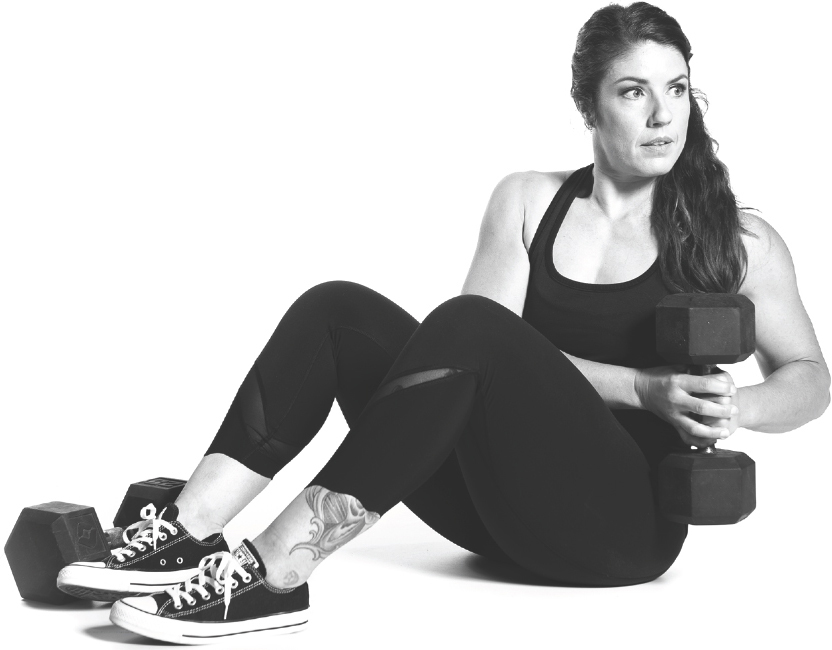
Sit on the floor with your knees bent, your feet flat on the floor, and a dumbbell held in both hands at chest height. Lean back, bringing your feet off the floor, and slowly twist your body to the right as you move the dumbbell toward your right hip. Keep your sit bones on the floor. Then rotate your body slowly to the left, moving the dumbbell toward your left hip. Keep the weight close to your body as you rotate from side to side.

SUPER(WO)MANS OR BIRD DOGS—4 sets of 10 reps

Lie facedown on the floor and extend your arms out in front of you. Engage your core and lift your arms and legs a few inches off the floor. Activate your back and butt muscles, moving slowly until you reach a comfortable maximum height. Hold for 1 to 3 seconds, then return to the starting position.
Pro Tips
» To make it harder, increase the reps.
» To make it easier, decrease the reps, or don’t lift as far off the floor. You can also substitute with bird dogs: position yourself on all fours on the floor and extend one arm out in front of you while also extending the opposite leg out behind you, keeping your weight centered; then switch the arm and leg.
LEVEL 2

BARBELL BACK SQUATS—5 sets of 5 reps at RPE 7
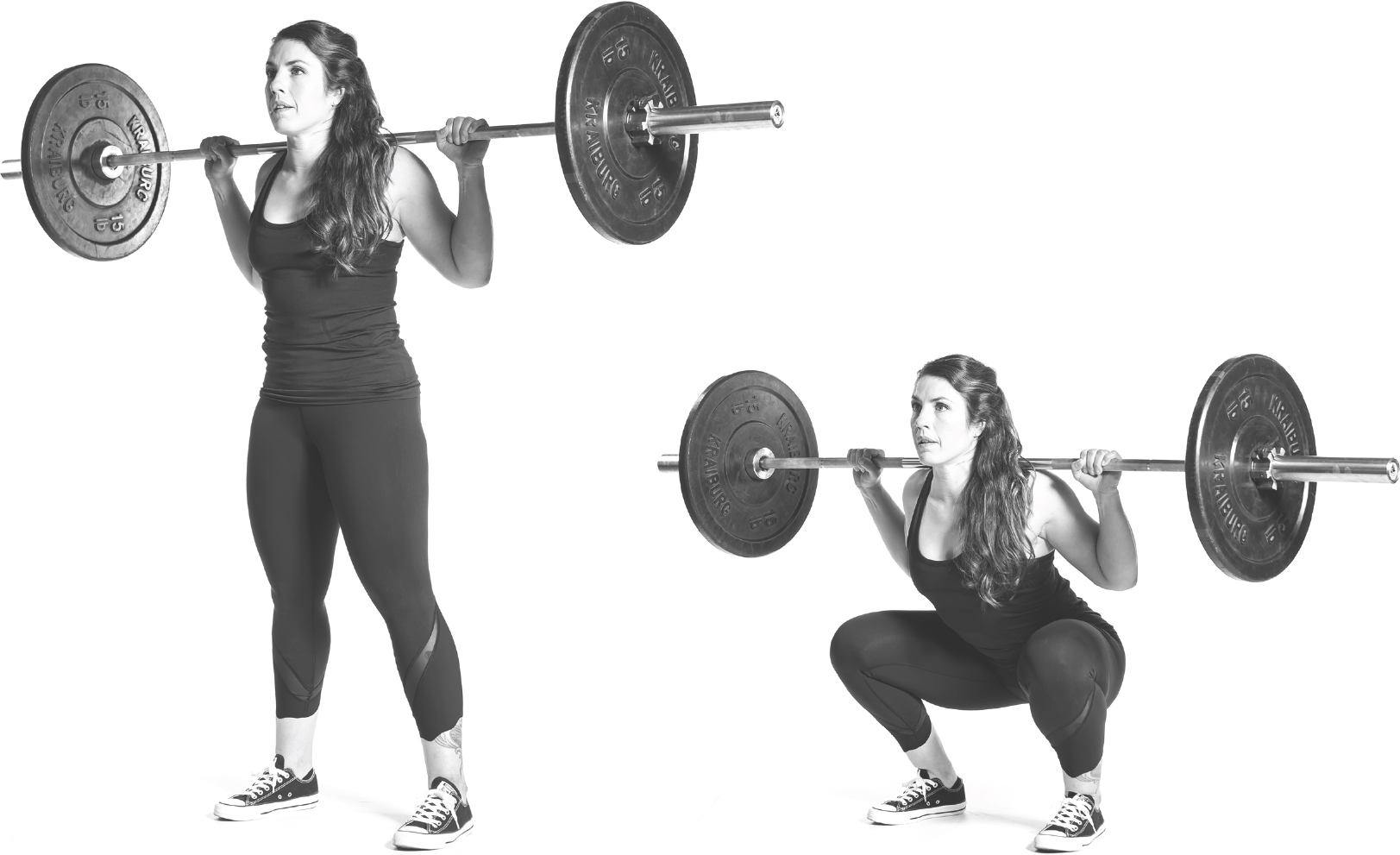
Stand with a barbell resting across the meaty back of your shoulders, called the trapezius muscles, and held in an overhand grip. Don’t let the barbell rest on your neck bones. Inhale, engage your core, squeeze your glutes, and hinge at the hip before bending your knees to lower your butt toward the floor until your thighs are parallel to the floor or slightly lower. Keep your neck neutral and your chest high, then return to the starting position, exhaling on the way up.

BARBELL SHOULDER PRESSES—3 sets of 5 reps at RPE 6

Stand with your feet under your hips and holding a barbell across the front of your shoulders with an overhand grip. Your hands should be slightly wider than shoulder width apart. Engage your core and press the barbell toward the ceiling. Maintain a neutral posture and pull your ribs down instead of flaring them out. Return to the starting position.

PULL-UPS—4 sets of 5 or more reps
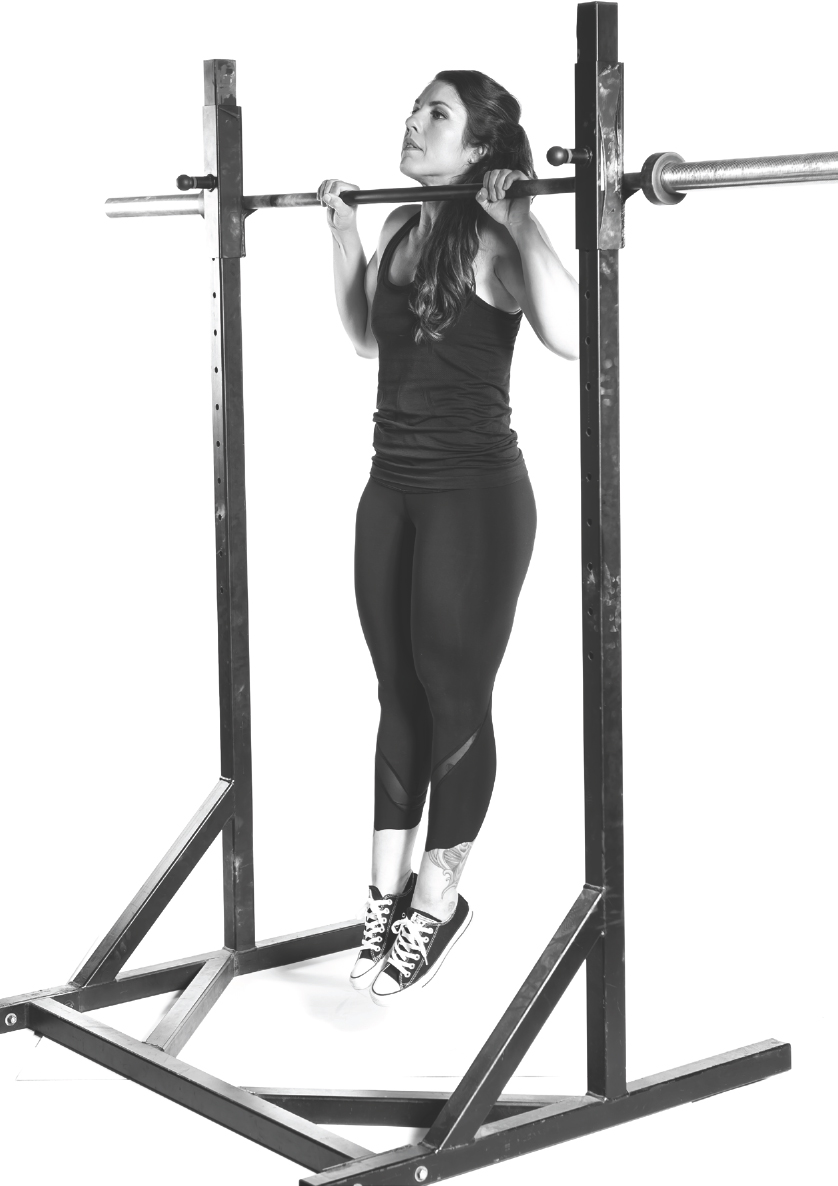
Stand under a pull-up bar with your hands gripping the bar underhand or overhand (your choice) and shoulder width apart. Your thumbs should be wrapped all the way around the bar. Inhale as you engage your core and pull your body up until your chin clears the bar. Keep your neck neutral—don’t crane your chin over the bar. Then lower back to the starting position with control to protect your shoulders.
Pro Tips
» To make it easier, secure a band around the bar and place your feet in it to reduce the amount of weight you’re pulling up. Or start at the top of the pull-up position and then lower yourself down instead of doing the complete rep.

WINDMILLS—3 sets of 10 reps on each side
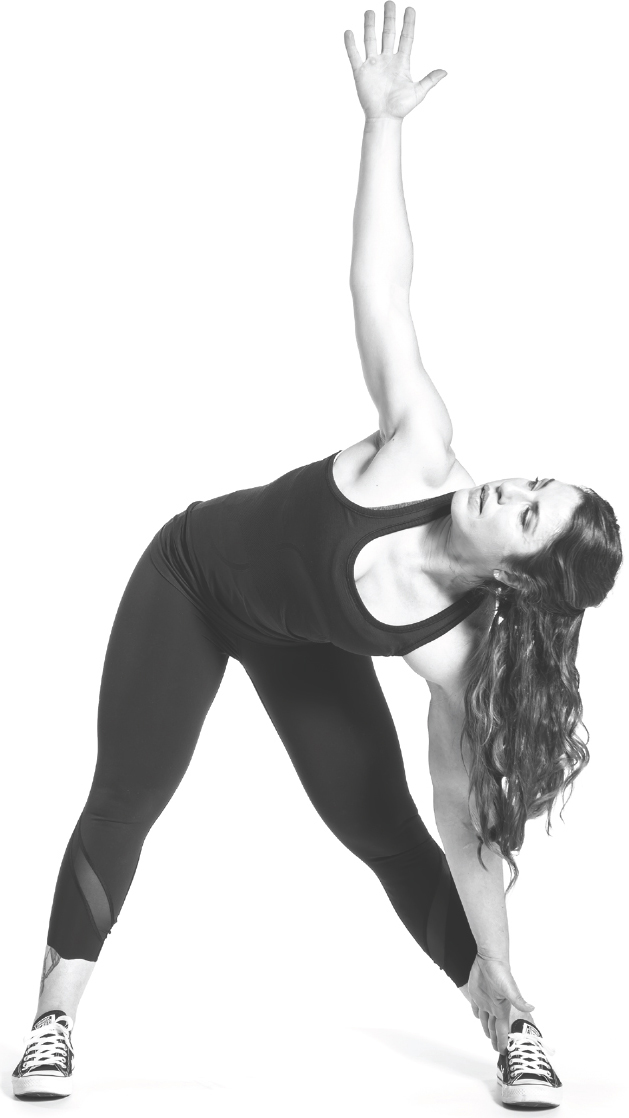
Stand with your feet slightly wider than hip width apart and with your arms extended out to your sides at shoulder height. Engage your core and twist your body to bring your right hand toward your left foot. Return to the starting position, upright, and then twist your body to the left, bringing your left hand toward your right foot. Return again to the starting position and repeat.
Pro Tip
» To make this harder, hold a light dumbbell in the hand that’s overhead. Do all the reps on one side before switching the dumbbell to the other hand and doing the reps on the other side.
DAY 23: MODERATION
There’s a famous saying: “Everything in moderation.”
This phrase is tricky for a few reasons, the most important of which is that some things, in moderation, are super unhealthy or can cause disease, allergic reaction, or even death. I know it’s an attempt to sum up a philosophy on life, but it really comes down to you. Is [insert anything] in moderation a good idea for you? For example, what if you have celiac disease? Any amount of gluten in your diet will seriously impact your health.
Always consider your goals, needs, and context when playing with the idea of moderation.
Some of my clients identify themselves as moderators, those who live by the “Everything in moderation” philosophy, while others avoid certain foods, drinks, habits, or behaviors 100 percent of the time. For example, I abstain from alcohol, but I’m a moderator when it comes to chocolate. (A square or two of dark chocolate is usually all I need to feel satisfied.) You might have the opposite consumption habit and be a moderator when it comes to alcohol but abstain from chocolate. Or maybe you moderate both . . . or abstain from both.
This is where things get tricky.
Willpower Versus Inner Power
There’s a difference, energetically, between avoiding something because it’s the only way to control yourself and choosing to avoid it because it makes you feel less good. I know it’s technically the same thing at the end of the day—you just don’t eat or drink or do that thing—but the effect it has on your willpower and energy is undeniable. The former is more draining and disempowering. The latter is owning your choices, and that’s inner power.
If you avoid certain foods not because they make you sick or make you feel less than good, be very clear about why. Here’s an example: one of my clients did everything in her power to never eat french fries. She believed they were bad for her—an off-limits food—because she felt she couldn’t control herself. She decided that if she couldn’t eat a whole order of fries, then it was better to never eat a single one.
Every time she went out to eat with friends and saw them order french fries, a back-and-forth dialogue went through her mind. She’d spend the whole meal thinking about fries.
When she got home—particularly if her day had been stressful—she’d order takeout and almost always follow it up with overdoing it on something sugary before bed. I finally asked her, “What would happen if you let yourself get french fries? Could you eat a few and be satisfied?”
“Yes,” she admitted, “but I’d be afraid I’d eat all of them.” From there I asked her to get clear about her fear. It all pointed back to her not trusting herself to stop. She ended up in a mental tug of war, which then used up her willpower and left her feeling more stressed. In this state of mind, she almost invariably overdid it with other “bad” food.
And if she ate them all, we reframed it: She didn’t go out to eat every day and order french fries at every meal. She could own her choice and move on.
She ultimately ordered the fries, ate about half, and stopped eating. Plus, she didn’t go home and overdo it that night. The wonderful part was that she lost the mental anguish and shameful self-talk, and she mindfully made the best choice for her in that moment. She finally felt empowered to make decisions about food for herself.
I’m not saying that you need to flip-flop on everything you’ve ever done. My hope is that you’ll take a look with more awareness of what’s driving your decisions. Are you coming from a place of love and compassion for yourself? Or is your reaction motivated by fear?
Food for thought.
Day 23 Challenge: Journal Your Answers to These Questions
What foods do you moderate?
What foods do you avoid?
What role, if any, does fear play in the things you avoid eating?
DAY 24: PERFECTLY IMPERFECT
I want to mention a hot topic in the fitness world: body perfection.
My weight has fluctuated quite a bit in my adult life. I was at my lowest weight when I was an Xterra athlete, doing a ton of endurance mountain biking and not eating enough, but I still wasn’t happy with my body because I wasn’t “thin enough” in my own eyes. The point is, as you can imagine, my happiness was not actually tied to my bodyweight because I could not be satisfied no matter how small I got.
When I found weight training through CrossFit in 2010, things significantly changed for me. I put on muscle mass and got a whole helluva lot stronger. I’d already been eating better for six months, and my health was improving. And even though I was “bigger,” I didn’t hate my body anymore. Why? I shifted my focus to health and the amazing things my body could do instead of reaching an exact scale weight.
I’ve come to appreciate my capable body, and it’s my hope that the same will happen for you. You don’t have to have a six-pack or be 10 percent body fat to have worth as a person.
In other words: Your worth is not found in your physical body, despite what society says.
So, yes, I love my thick thighs . . . even if they make finding pants a challenging task sometimes.
Please take some time to think about whether your aspirations for your physical body are realistic, safe, healthy, and/or worth the time and sacrifice they’ll take to achieve. If, for example, you’re pouring a huge amount of time, energy, and self-deprivation into seeing your abs, honestly evaluate the trade-off. Is the cost worth the benefit? Is it giving you more than it’s taking from you? Both important questions.
Day 24 Challenge: Work Out
Movements from last week make a great dynamic warm-up. Complete all sets and reps of each movement before moving on to the next.
Squat Mobilization
Hopefully you’ve been finding some new favorite mobility drills to target stiff areas of your body before you work out.
Let’s talk about my favorite squat mobility drill: hip openers. Yes, squats demand mobility in several areas of your body, from your ankles up to your thoracic spine. But perhaps the area that takes the most heat from regular squatting (and sitting) is the hip area. The glutes, hip flexors, and hamstrings can end up tight, overused, or imbalanced.
If you haven’t tried these two yet, incorporate them before your workout today:
GLUTE MASSAGE: Take a lacrosse ball or softball and position it under one of your glutes, right in the meaty butt cheek. Search for a tight spot. Then lean a bent knee over outside the hips to the left or right. Do this several times. You can even move the lacrosse ball toward the outer part of the hip. Your butt cheek will feel softer instead of tense and knotted.
SITTING HIP MOBILIZATION (GREAT TO DO AT YOUR DESK DURING THE DAY!): Sit in a chair and cross your left foot over your right knee so your shin is parallel with the floor. Fold slightly forward. You can keep the left foot from sliding off your knee by holding it down with your hand. Gently push your left knee down.
LEVEL 1

GLUTE BRIDGES—4 sets of 10 reps

Lie on your back with your knees bent, your feet flat on the floor and close to your hips, and your arms at your sides on the floor. Engage your core and squeeze your butt as you slowly drive your hips up toward the ceiling so that your body is in a straight line from head to knees. Keep your knees parallel to each other; don’t let them collapse in or out. Slowly lower your hips back to the starting position.
Pro Tip
» To make it harder, lift up one leg at a time from the bridge position.

SPLIT SQUATS—4 sets of 10 reps with each leg

Stand with your feet under your hips and with dumbbells held at shoulder height. Step forward with your left leg into a lunge stance. Engage your core and gently lower your right knee toward the floor until both legs form 90-degree angles. Return to a standing position, then lower your right knee again. Do all reps on this leg before driving through your front foot, engaging your glutes, and returning to the starting position. Repeat with opposite leg positions.
Pro Tip
» To make it harder, place your back foot up on a bench (to do a Bulgarian split squat).

ALTERNATING DUMBBELL ROWS—4 sets of 8 reps with each arm
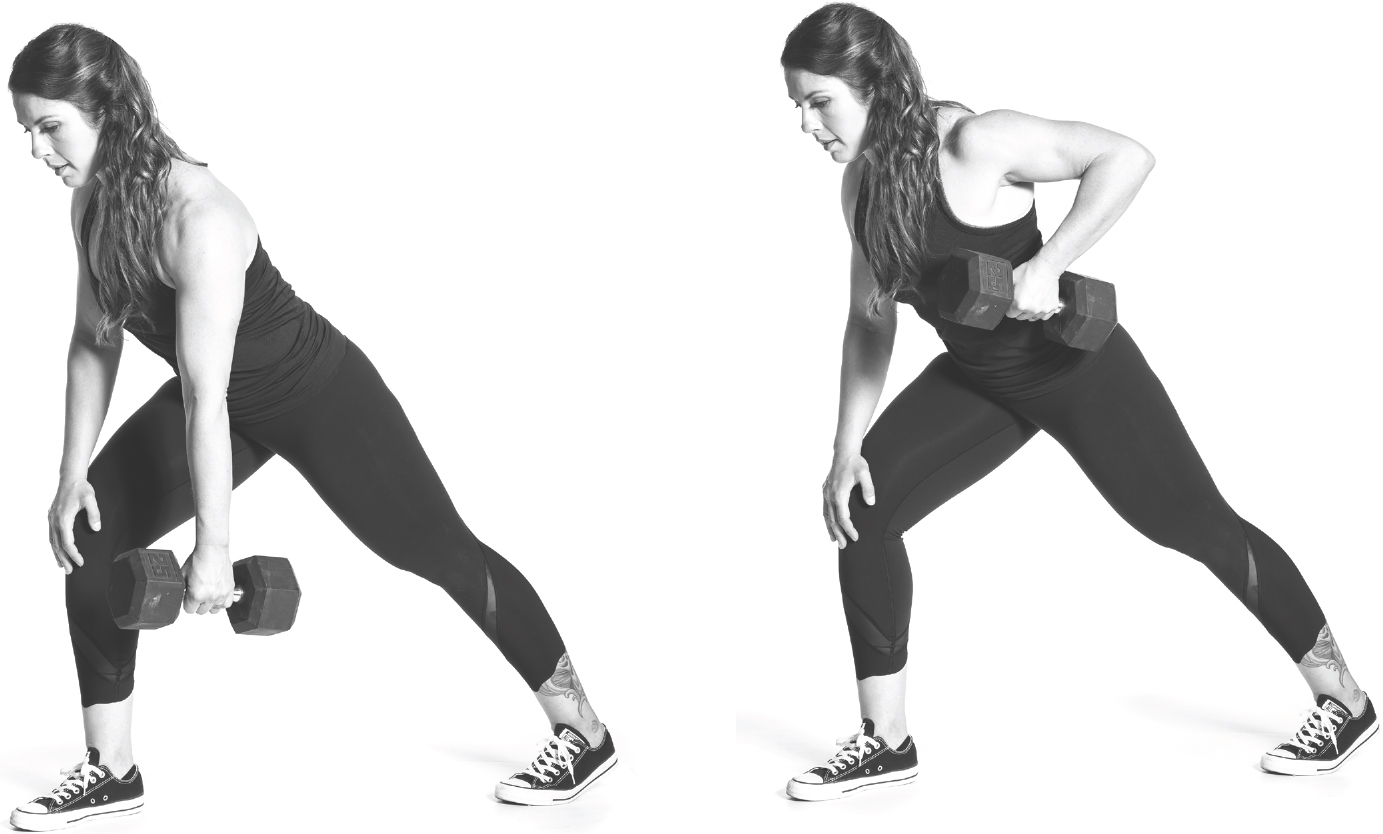
Holding a dumbbell in your left hand, to begin with, stand with your right foot forward in a partial lunge and your body from your left heel to the top of your head forming almost a straight line. Keep your abs engaged, your spine aligned, and your elbow close to your body as you pull the dumbbell up to your ribs, then lower it. You can rest your other hand on your knee or your leg for support. Repeat the movements on the opposite side.

DIPS—3 sets of 6 to 8 reps

Sit on a sturdy bench or box with your hands next to you and your feet about twelve inches in front of your hips. Slide your bum off the bench, and keeping your body close to the bench, bend your arms to slowly lower your body a few inches below the bench, then drive back up, using your triceps, to the starting position.
Pro Tips
» To make it easier, set your feet closer to your body.
» To make it harder, set your feet farther from your body.

WAITER WALKS—4 sets of 50 feet with each arm

Stand with your feet under your hips and hold light- to moderate-weight dumbbells in each hand. Press your right dumbbell up toward the ceiling, actively pushing through your shoulder and keeping your right arm close to your head. Then walk with the dumbbell overhead. Pull your ribs down instead of flaring them out. Repeat the movements with your left arm.
LEVEL 2

BARBELL DEADLIFTS—1 set of 5 reps at RPE 7
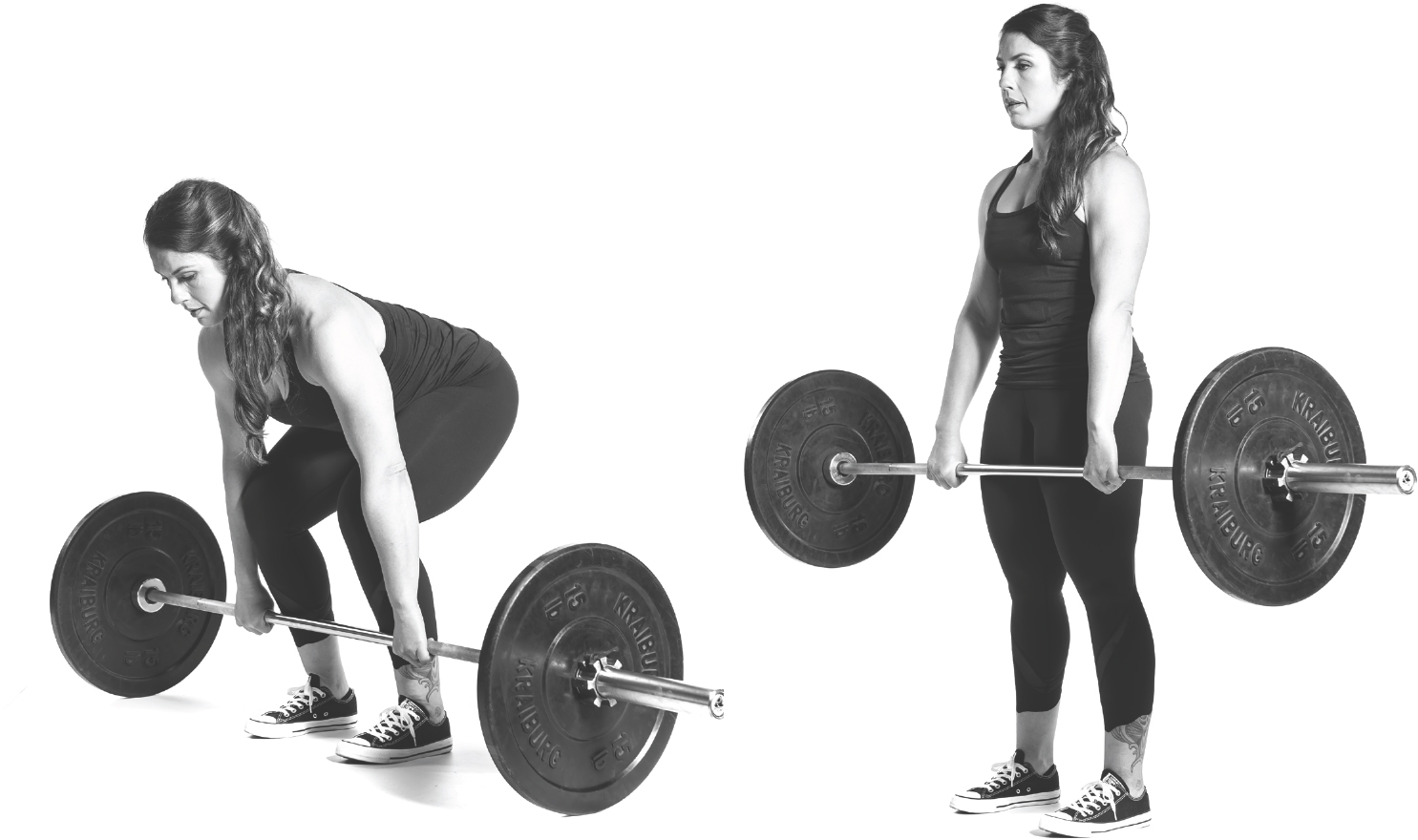
Stand with your feet under your hips with a barbell on the floor close to your shins. Hinge at the hips and grasp the barbell overhand with your hands positioned just outside your hips. Inhale, engage your core, squeeze your glutes, and push the floor away with your legs instead of lifting your back to raise the barbell. Keep your neck neutral and the barbell close to your body as you come to a standing position, exhaling on the way up. Be sure to keep your toes from lifting off the floor throughout the movement. Hinge forward at the hips, lower the weight to the floor, and return to the starting position.

BARBELL POWER CLEANS—3 sets of 2 reps at RPE 7

Stand with your feet slightly wider than hip width apart and with a barbell on the floor in front of your feet. Hinge at the hips and grab the barbell overhand with your hands positioned just outside your hips. Lift it to your thighs, then push with your legs and jump as you bend your elbows to flip the bar up and shrug it to your shoulders. The power comes from your legs driving the bar up rather than pulling it with your arms. Stand in a partial squat with your knees slightly bent. Pause briefly, then return the bar to the floor.
Pro Tip
» To make it harder, use an unbalanced object like a sandbag, or receive the weight in a full squat clean.

PUSH-UPS—4 sets of 5 or more reps

Lie facedown on the floor and place your hands on the floor next to your body at about chest level, with your elbows close to your sides. Your body should look like an arrow if you could view it from above, not the letter T. Push your body up so that you’re on your hands and toes, keeping your body in a straight line. Don’t stick your butt up into the air or drop your butt too low. Bend your elbows to lower your chest toward the floor, and then push back up. As you push up, take a breath and keep your butt and core tight.
Pro Tip
» To make it harder, add weight on your back, or try clapping push-ups.

SUPER(WO)MANS OR BIRD DOGS—4 sets of 10 reps

Lie facedown on the floor and extend your arms out in front of you. Engage your core and lift your arms and legs a few inches off the floor. Activate your back and butt muscles, moving slowly until you reach a comfortable maximum height. Hold for 1 to 3 seconds, then return to the starting position.
Pro Tips
» To make it harder, increase the reps.
» To make it easier, decrease the reps, or don’t lift as far off the floor. You can also substitute with bird dogs: position yourself on all fours on the floor and extend one arm out in front of you while also extending the opposite leg out behind you, keeping your weight centered; then switch the arm and leg.
DAY 25: KISS
You’ve got just six days left in the Core 4 program . . . hard to believe! You’re rockin’ it. Let’s get right into today’s topic because it’s about magically freeing up more time in the day. I’m going to let you in on a secret way to find more time to get those things done that you never can seem to accomplish.
Ready?
It’s called: Stop doing crap that isn’t important.
I know, the sarcasm is thick. But seriously, how many times have you created stuff for yourself to do to be “busy” so that you just couldn’t find time for things that really needed to get done? It seems to be part of human nature. You know you need to finish a work project—so you can free up the time to stop working extra hours on it at home—but instead you decide to alphabetize your spice rack or de-lint your couch.
Not that organized spices or a de-linted couch are bad, but you need to ask yourself, “What’s the priority here?” (Remember the Values Inventory Worksheet from the Pillar 4 chapter!)
The quote “Stop the glorification of busy” really resonates with me. How many people do you know who fill their lives with meaningless stuff only to appear busy and important? I can think of at least a few, and I’m guilty of it from time to time.
My point is that if there’s something you want to accomplish, stop lollygagging around with less important things. Learn to prioritize. Take action on the most high-priority items by not doing the ones with lower priority. Remember your values and what matters to you most.
And to that, I say, “KISS,” or “keep it super simple.”
How to KISS
Do you need to make a twenty-five-ingredient, five-course dinner on a Tuesday night or will grilled chicken, sweet potato, and some spinach suffice? Three ingredients. Done.
Do you need to do five or six long workouts a week or is three enough? Three is probably plenty as long as they’re challenging.
Do you need to please everyone and ignore yourself? No. Constantly ignoring your own needs and happiness only makes you a more miserable and exhausted human to be around.
I think you see where I’m going. Simplify your life. Declutter, physically and mentally. Streamline. Look for ways to be more efficient, not less. It all comes down to less drain on your energy.
Day 25 Challenge: Try to KISS
Pick one thing you can simplify or place as a higher priority and do it. If you have a bottomless to-do list, focus only on what you intend to do today.
DAY 26: TECH BOUNDARIES
I love keeping things simple. But when it comes to technology, well, simple goes flying out the window. Like it or not, technology is here to stay. Tech has enriched our lives in some ways . . . and made it more difficult in others. Try to imagine your daily life without technology. Hard, right?
Will we ever live in a world that has less technology than we do today? Doubtful. But it’s easy to succumb—unless we’re vigilant—to mindless tech consumption thanks to our brains. Many types of tech and social media platforms are designed specifically to be easy to use. Very easy to use. In fact, so easy to use you don’t even think about it.
How? They help you complete the anticipation-reward loop I mentioned in the Pillar 3 chapter. The reward, you may think, will be a deeper or more convenient connection with people across the world or the ease of accomplishing tasks . . . but when you take a closer look, dopamine is at play.
Every hit of dopamine that comes with a ding from a new email or a text popping up is a reward. The problem is that dopamine’s effect doesn’t last. It’s fleeting. So you end up needing more, seeking it out via technology, checking, scrolling, and refreshing, often mindlessly. It may all sound a little sinister, but tech companies know how your brain functions . . . and they leverage that to keep you using their platforms.
Think of social media and other forms of technology like junk food. It’s delicious—so utterly delicious—because it pings all the right parts of your brain. But on a nutritional level, it sucks.
If tech is junk food, real-life relationships and interactions are like meat and veggies. Nourishing yourself with a base of meat and veggies, then eating junk food now and then, may be okay. Eating junk food 24/7 with the occasional meat and veggies tossed in? Not so much.
Creating Boundaries
Do you already have some boundaries about how you use technology? You may. But maybe it’s time for some reflection.
I’m not suggesting you stop using all technology. But take a look at how much you use it, how it’s making your life better (or not), and whether it’s time to add more meat and veggies (in-person, real interaction) into your “diet.”
For example, let’s say you got into the not-so-great habit of lying in bed while checking social media on your phone. Not only does it send mixed messages about what the bed is actually for (sleeping and sex), you’re plugged into the matrix until the very second you go to sleep.
Setting a boundary by charging your phone in the living room and plugging it in at least an hour before bedtime gives you a tech-free brain zone to help you decompress. Changing the habit may feel weird at first, but that’s okay.
Another simple fix is turning off the incessant stream of notifications from your apps (“on” is usually their default setting). Or something more meaningful, like calling your loved ones instead of texting them.
It’s up to you, but find at least one way today to feed yourself with the equivalent of meat and veggies instead of bingeing on tech “junk food.”
Day 26 Challenge: Set One Tech Boundary, plus Work Out
Movements from last week make a dynamic warm-up. Complete all sets and reps of each movement before moving on to the next.
LEVEL 1

SUMO DEADLIFTS—4 sets of 12 reps
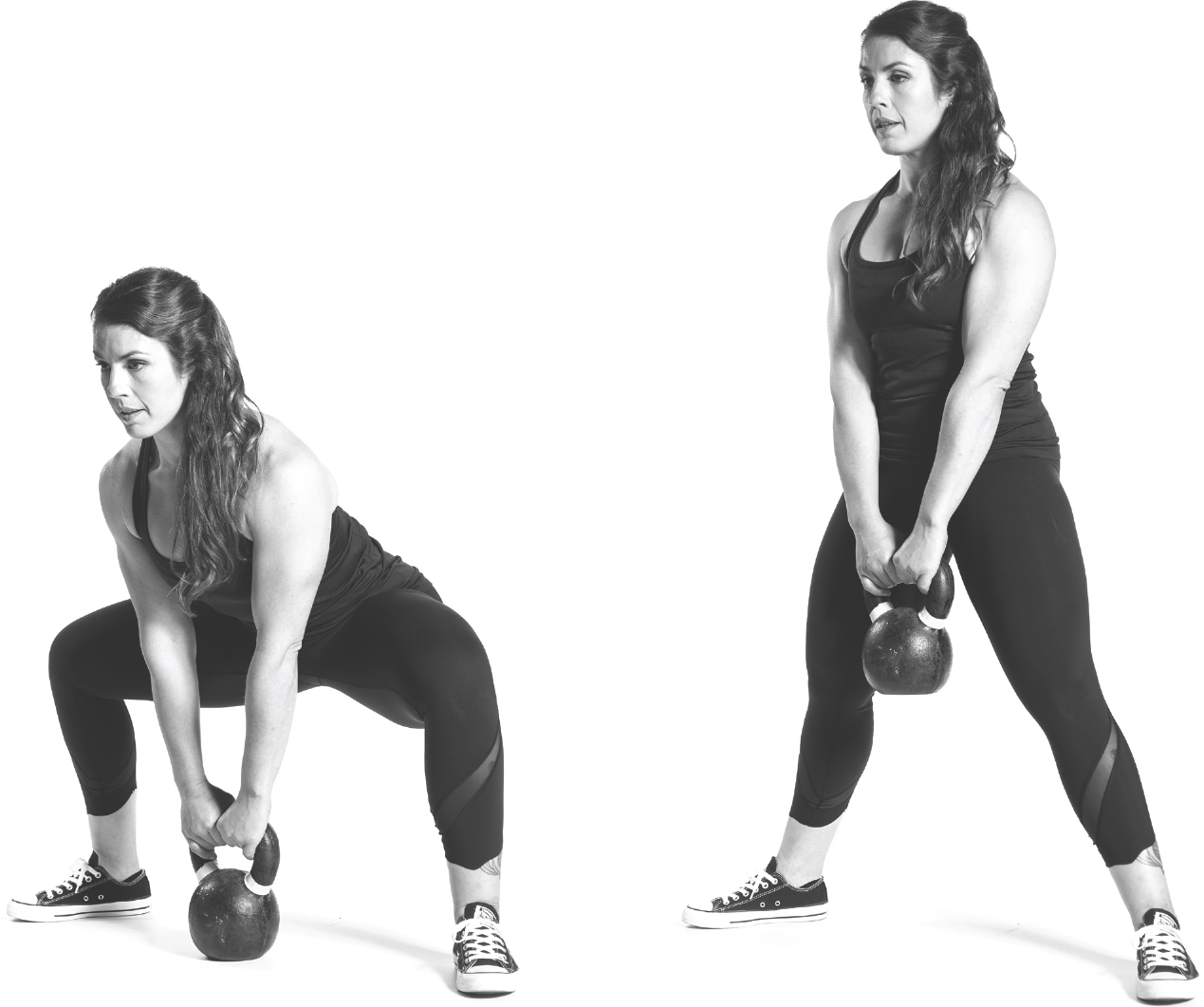
Stand with your feet about six to eight inches outside your hips and hold dumbbells or a kettlebell in front of your thighs with an overhand grip. Engage your core and keep your neck neutral as you hinge forward, bend your knees, and lower the weights until they touch the floor. Remember to push the floor away with your legs instead of lifting with your back. Return to the starting position, keeping the weight close to your body.

ALTERNATING LUNGES—3 sets of 12 reps with each leg
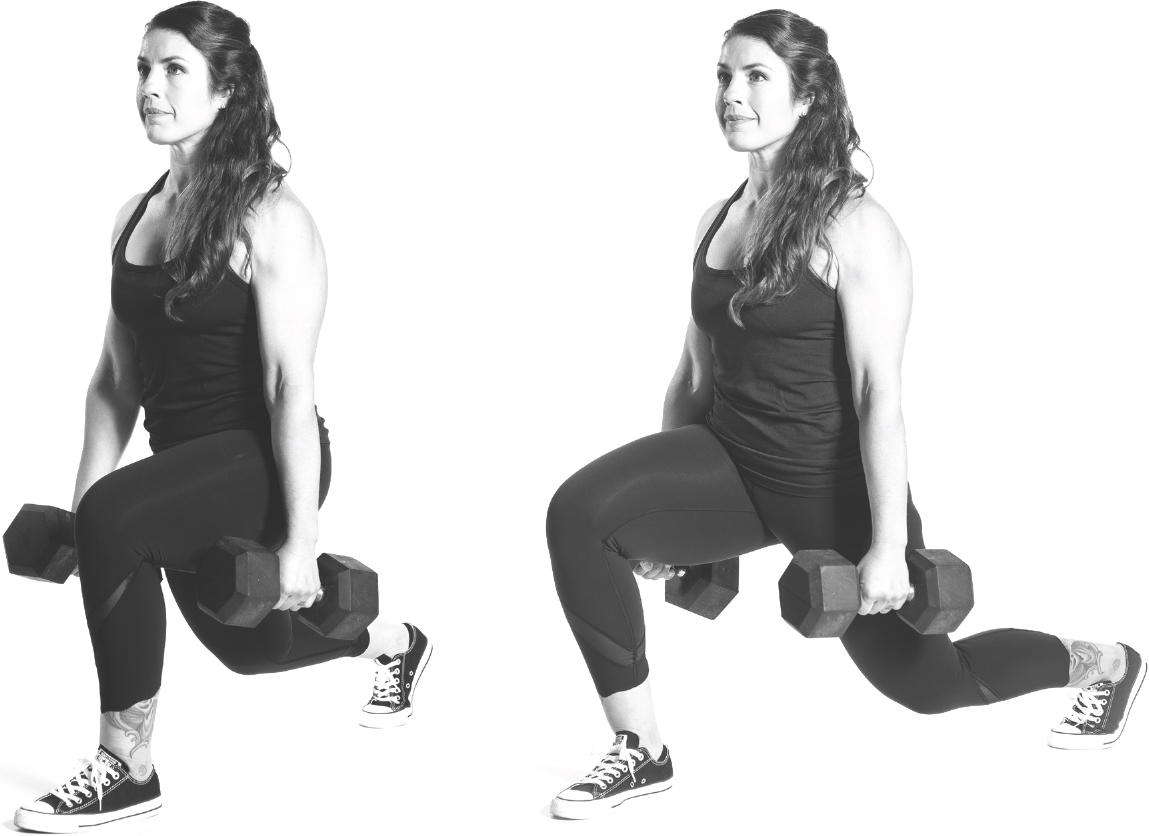
Stand with your feet under your hips, holding dumbbells in both hands. Step forward and bend your right knee to make a 90-degree angle with your right leg as you lower your left knee toward the floor. Drive through your front foot. Step forward with your left leg to bring your feet together. Repeat the movements on the opposite leg.
Pro Tips
» Make your step short enough that you can return to standing without swinging your torso.
» To make it harder, make them walking lunges, or hold the dumbbells over your head while you lunge.

ALTERNATING DUMBBELL SHOULDER PRESSES—3 sets of 10 reps with each arm
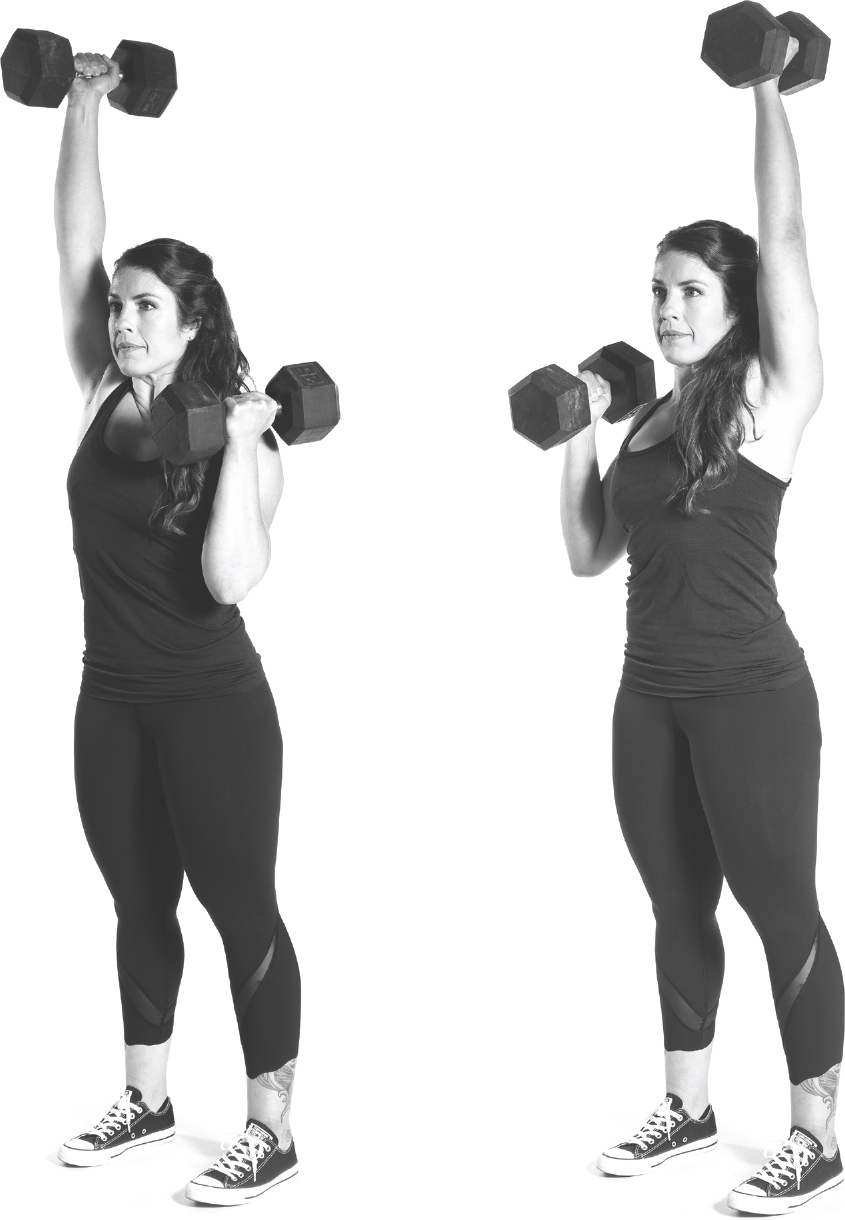
Stand with your feet under your hips and with dumbbells in both hands held at shoulder height, with your knuckles facing your shoulders. Engage your core, squeeze your butt, and keep your neck neutral as you actively push up through the shoulder to raise one dumbbell toward the ceiling. Keep your arm close to your head. Also, pull your ribs down instead of flaring them out. Lower the dumbbell and repeat the movements with the opposite arm.
Pro Tip
» To make it harder, press both dumbbells up at the same time, or use a barbell.

SKULL CRUSHERS—3 sets of 10 reps

Lie on a weight bench, or on the floor with your knees bent and your feet flat on the floor, and hold one end of a dumbbell in your hands as pictured, with your arms extended. Engage your core as you bend your elbows to lower the dumbbell straight down toward the top of your head. Pull your ribs down instead of flaring them out. Then straighten your arms again, focusing on the triceps—the backs of the upper arms—to return the dumbbell to the starting position.

PULL-UPS—4 sets of 6 to 8 reps

Stand under a pull-up bar with your hands gripping the bar underhand or overhand (your choice) and shoulder width apart. Your thumbs should be wrapped all the way around the bar. Inhale as you engage your core and pull your body up until your chin clears the bar. Keep your neck neutral—don’t crane your chin over the bar. Then lower back to the starting position with control to protect your shoulders.
Pro Tips
» To make it easier, secure a band around the bar and place your feet in it to reduce the amount of weight you’re pulling up. Or start at the top of the pull-up position and then lower yourself down instead of doing the complete rep.

PLANKS—4 sets of 30 to 45 seconds

Lie on the floor facedown with your hands next to your chest and your elbows close to your sides. Take a breath and push your body up onto your toes and hands, engaging your core and keeping your body in a straight line. Don’t stick your butt up in the air or let your hips sag. Hold this position, breathing normally.
Pro Tip
» To make it harder, add weight to your back, or lift one leg off the floor.
LEVEL 2

BARBELL BACK SQUATS—3 sets of 3 reps at RPE 7
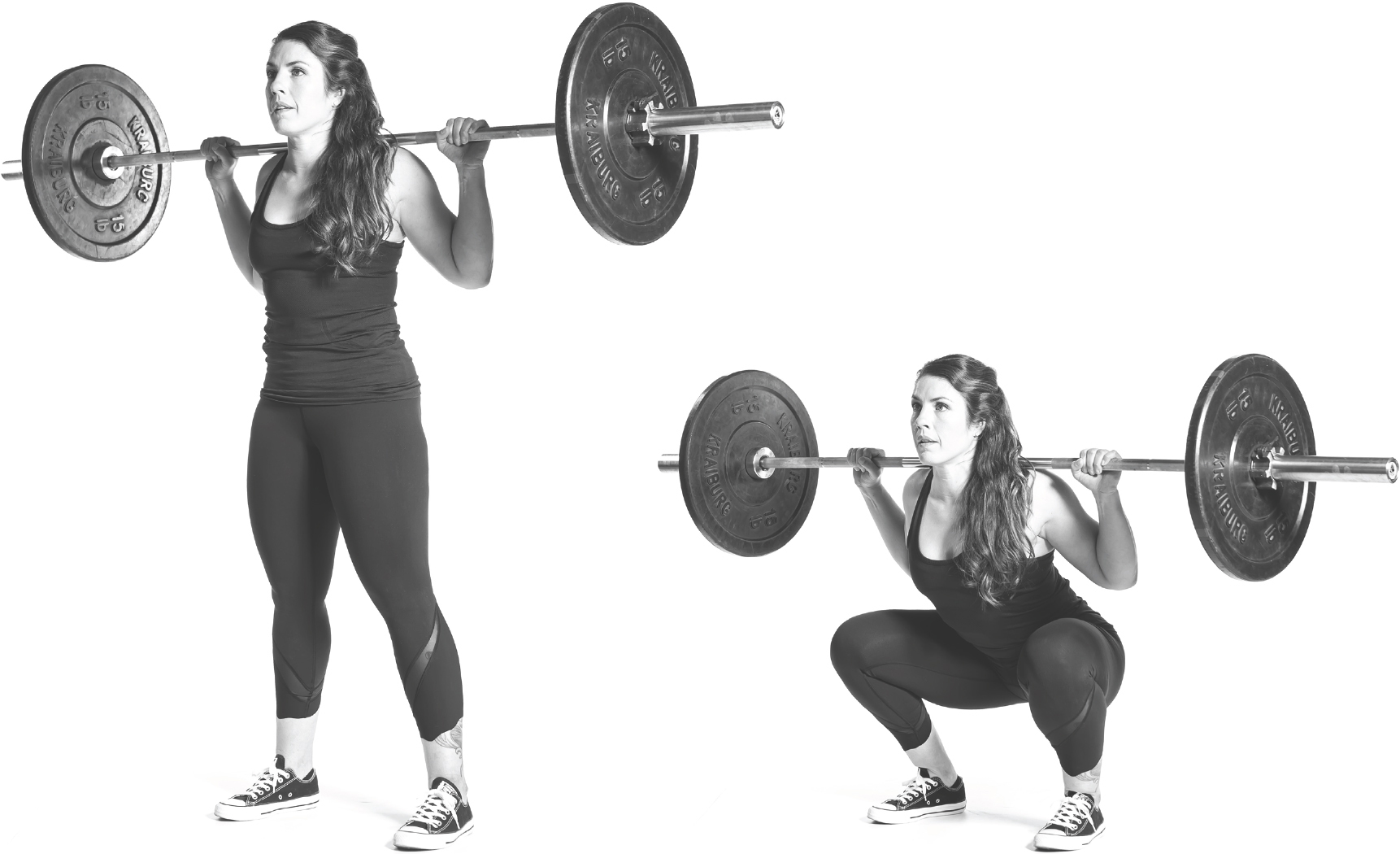
Stand with a barbell resting across the meaty back of your shoulders, called the trapezius muscles, and held in an overhand grip. Don’t let the barbell rest on your neck bones. Inhale, engage your core, squeeze your glutes, and hinge at the hip before bending your knees to lower your butt toward the floor until your thighs are parallel to the floor or slightly lower. Keep your neck neutral and your chest high, then return to the starting position, exhaling on the way up.

BARBELL SHOULDER PRESSES—3 sets of 3 reps at RPE 7

Stand with your feet under your hips and holding a barbell across the front of your shoulders with an overhand grip. Your hands should be slightly wider than shoulder width apart. Engage your core and press the barbell toward the ceiling. Maintain a neutral posture and pull your ribs down instead of flaring them out. Return to the starting position.

PULL-UPS—4 sets of 5 or more reps
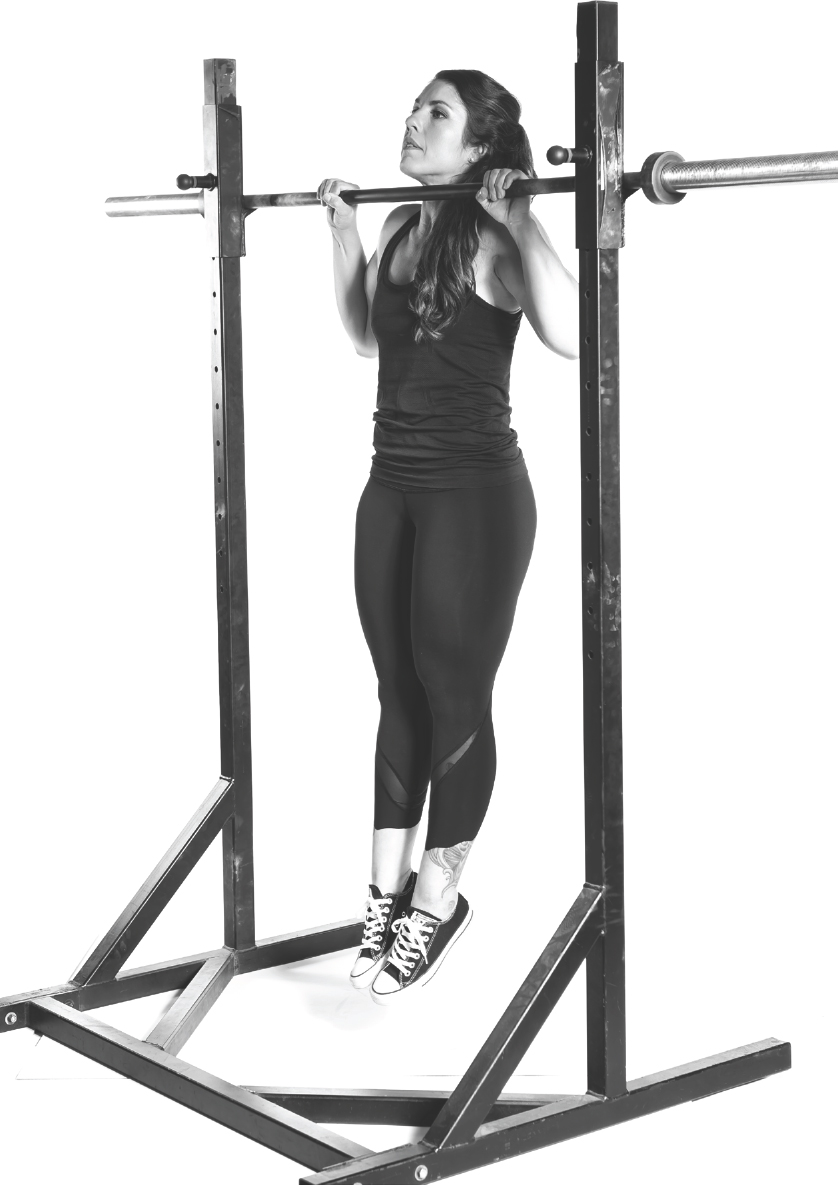
Stand under a pull-up bar with your hands gripping the bar underhand or overhand (your choice) and shoulder width apart. Your thumbs should be wrapped all the way around the bar. Inhale as you engage your core and pull your body up until your chin clears the bar. Keep your neck neutral—don’t crane your chin over the bar. Then lower back to the starting position with control to protect your shoulders.
Pro Tips
» To make it easier, secure a band around the bar and place your feet in it to reduce the amount of weight you’re pulling up. Or start at the top of the pull-up position and then lower yourself down instead of doing the complete rep.

PLANKS—4 sets of 30 to 45 seconds

Lie on the floor facedown with your hands next to your chest and your elbows close to your sides. Take a breath and push your body up onto your toes and hands, engaging your core and keeping your body in a straight line. Don’t stick your butt up in the air or let your hips sag. Hold this position, breathing normally.
Pro Tip
» To make it harder, add weight to your back, or lift one leg off the floor.
DAY 27: YOUR CIRCLE
Yesterday you learned that there is no substitute for the real-life connections you have. Today you’ll focus on the special people in your life.
When I was a triathlete, my weakest discipline was swimming. I was a back-of the-pack swimmer, but no matter how much I struggled, I always reminded myself to just keep moving forward, even if it meant doing the dog paddle or backstroke (which, incidentally, I had to do a lot).
Whenever you make big changes or try new things, it can be really scary. (Remember what you learned about fear on Day 18?) You may feel tons of uncertainty, but the most important thing to do is to move forward even if you’re taking baby steps. Taking action when you’re afraid is better than letting fear stop you cold.
Even the strongest, most self-directed people need support from time to time. You may be all Ms. Independent, saying, “I don’t need anyone. I can do it myself.” But chances are there’s someone somewhere who has supported, guided, cheered, or motivated you.
It’s hard to do big courageous things completely in solitude. Not impossible, just less common than you’d think.
Your Circle
Who has stood by you?
Who has offered you a helping hand when you needed it?
Who has given a shoulder for you to lean on?
Who has kicked your butt and told you that you’re not quitting?
Who has encouraged you to be your best?
Your answers to these questions may be all the same person or different people. Make a mental note of who they are.
Now think about who has given you grief, stood in your way, been a roadblock, told you that you can’t, etc. Often we have people in our lives who do nothing but tear us down. If you’re a loyal person, you may find it difficult to step away from the people in your life who are blocking you.
Weeding the Friend Garden
If there’s someone in your life who keeps crapping on your dreams, you don’t have to stay friends. You can set boundaries. Step into your inner power and take responsibility.
Relationships are tricky, and sometimes they run their course. It’s worth reflecting on. If someone’s holding you back, what are you going to do about it?
You have a choice: either weed the friend garden or continue letting others keep you down. But you know the latter isn’t what strong women do. If a friendship is not serving you anymore, wish the person well and move on.
Day 27 Challenge: Call, Write, or Talk to Three People Who Have Supported You When You Needed It Most
A simple “Thank you for being there for me” could be the highlight of their day. Of course, you can make it more in-depth. Cultivating an attitude of gratitude is one of the best ways to feel high on life. It works. Try it.
OPTIONAL WEEKEND WORKOUT. Do 4 rounds of the following exercises, resting 2 minutes after each round.

PULL-UPS (OR ALTERNATING DUMBBELL ROWS)—4
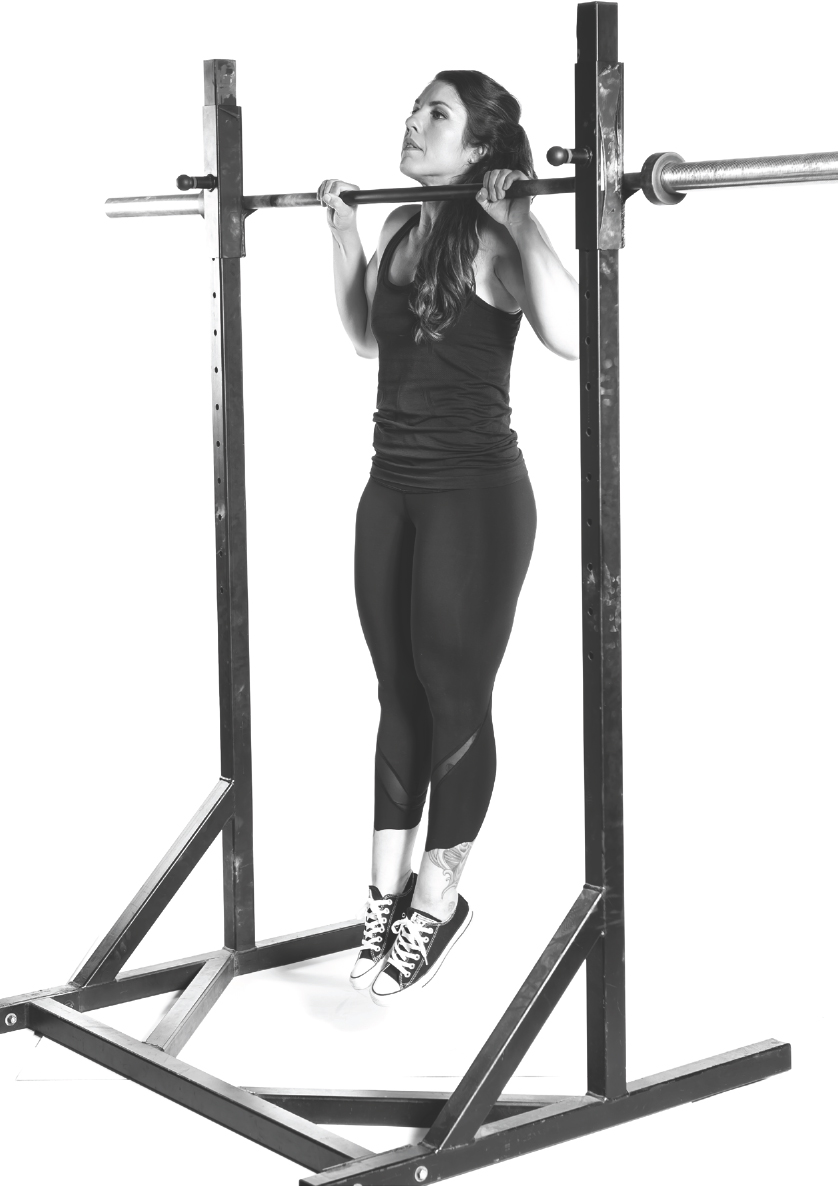
Stand under a pull-up bar with your hands gripping the bar underhand or overhand (your choice) and shoulder width apart. Your thumbs should be wrapped all the way around the bar. Inhale as you engage your core and pull your body up until your chin clears the bar. Keep your neck neutral—don’t crane your chin over the bar. Then lower back to the starting position with control to protect your shoulders.
Pro Tips
» To make it easier, secure a band around the bar and place your feet in it to reduce the amount of weight you’re pulling up. Or start at the top of the pull-up position and then lower yourself down instead of doing the complete rep.

RENEGADE ROWS—6 on each arm
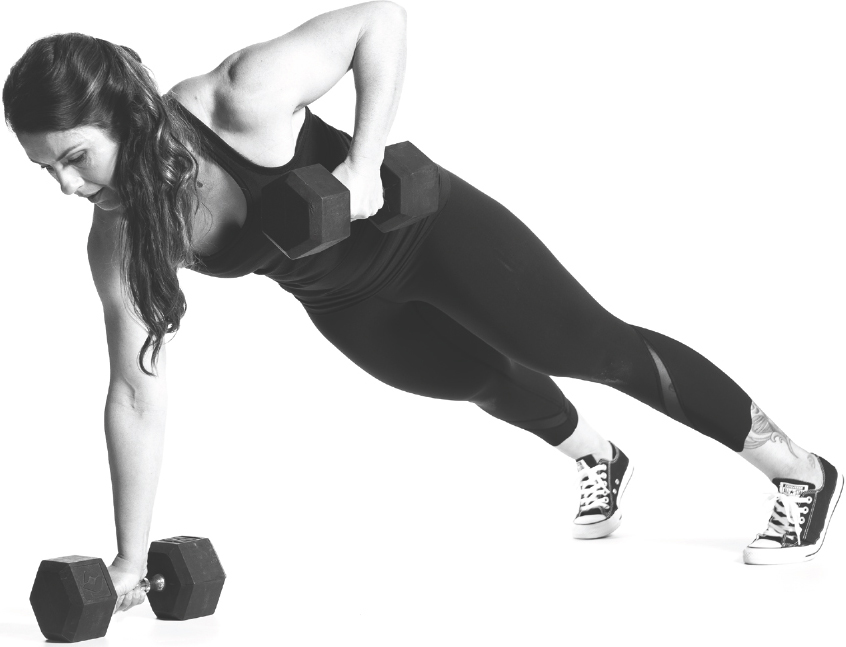
Lie facedown on the floor with dumbbells on either side of your body at about chest level. While grasping the dumbbells, push your body up into a plank position. Shift your weight onto your right arm and bend your left arm to row that dumbbell up to the left side of your rib cage. Actively pull with the upper back into each row, keeping the arm close to your body. Lower the dumbbell to the floor and repeat the movements with the other arm.

WALKING LUNGES—8 with each leg
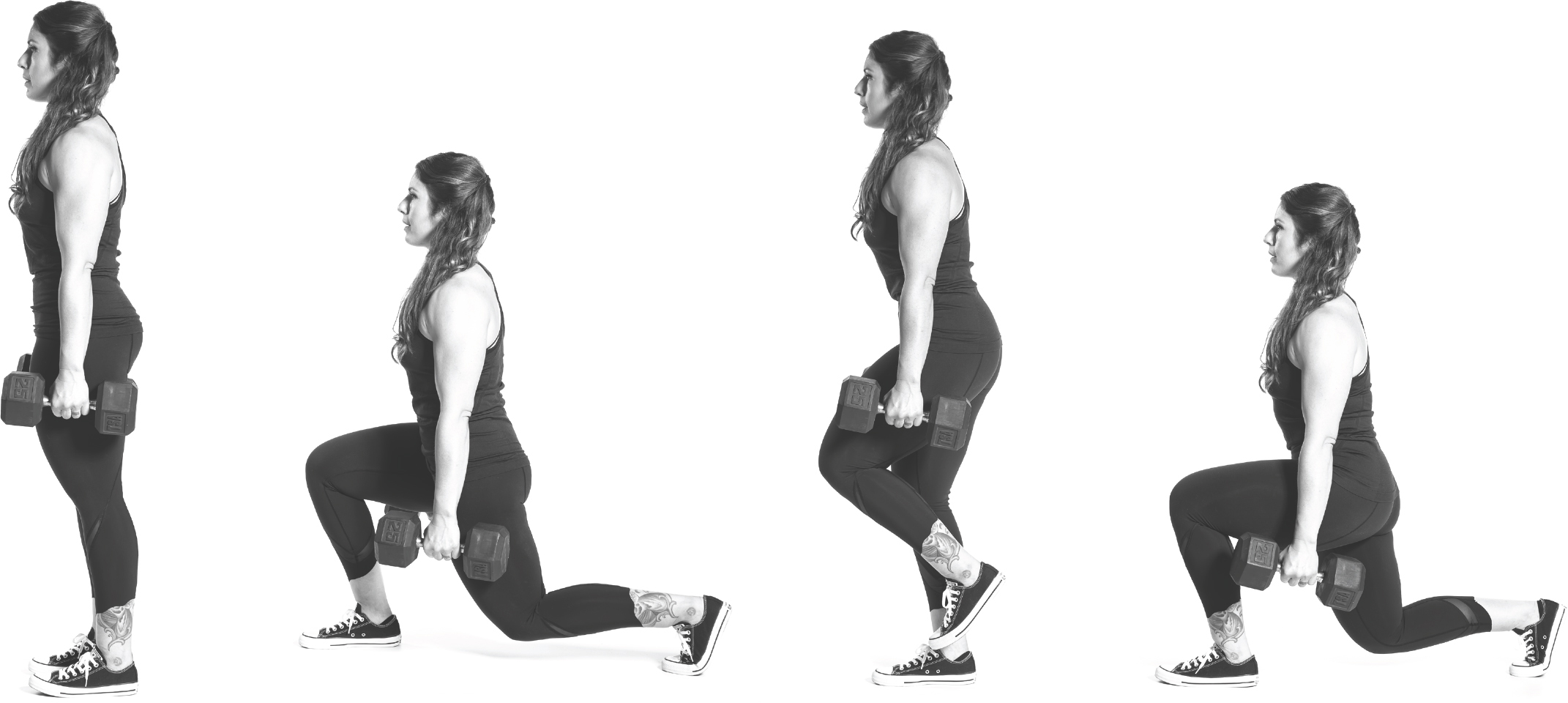
Stand with your feet under your hips, holding dumbbells in both hands. Step forward and bend your right knee to make a 90-degree angle with your right leg as you lower your left knee toward the floor. Drive through your front foot. Step forward with your left leg and repeat the movements on the opposite leg, walking slowly forward.
Pro Tip
» To make it harder, hold the dumbbells over your head while you lunge.
DAY 28: GRATITUDE
Yesterday’s challenge may have left you feeling a little warm and fuzzy inside. You know what? That’s a good thing. Let’s keep that going today. There’s one simple practice that can make an enormous impact on your life. It’s so simple that it seems too good to be true. It’s gratitude.
Gratitude is defined as “the quality of being thankful.” Today’s stressful modern world often magnifies what we’re lacking and distracts us from taking the time to express our thankfulness. There’s compelling research from Dr. Robert Emmons of UC Davis demonstrating the positive effects of practicing gratitude, including
better, more restful sleep;
lower blood pressure;
stronger immunity;
greater happiness;
deeper feelings of social confidence; and
more compassion for others.
It appears that the benefits of practicing gratitude come directly from a decrease in stress. Simply put, when you’re grateful, it’s easier to stay grounded in the present (instead of feeling stressed about the past or the future). This brings positive emotions to the forefront. Staying aware of the good you have in your life means you focus less on the bad.
There’s an interesting paradox about happiness that’s also been studied by scientists: happiness is both a cause and an effect of success. Most people treat happiness as an effect: “I’ll be happy when I lose those last 10 pounds.” “I’ll feel better about myself when I get that raise.” “Life will be happy when I find the perfect mate.”
But the most successful people—the ones who meet their goals—know that they must cultivate happiness in order to find success. Happiness and other positive emotions expand your thinking and creativity, quite the opposite of what occurs when you’re stressed. Stress makes it harder to see alternative solutions to your problems. By including gratitude as a practice, you bolster positive emotions and happiness, which are a cause of success as much as they are an effect.
Practice Makes Perfect
The great lie perpetuated by our technology-driven world—where we voyeuristically peek into other people’s lives—is that, gosh darn it, they’re so much happier than we are. It seems others are blessed with big, fun, exciting things and, well, we lead bland lives by comparison.
Remember that what you see on social media and TV is a filtered, curated view. People less frequently share their struggles and dark times or even the mundane but satisfying moments.
The antidote is developing a keen eye for small but joyful moments that pop up in your everyday life. The big, fun, exciting things may happen only once in a blue moon. The little, joyful things happen all the time . . . even when you’re going through a rough patch. There’s always sunlight.
But much like you can’t build muscle by just staring at a dumbbell, you can’t develop more happiness and enjoy the benefits of gratitude without practice. One place to start is simply by noticing such things. When something heartwarming, joyful, and gratifying happens, it’s time to take note.
A mental note is great—sit in that moment and savor it—but writing it down is even more powerful. My favorite personal practice, and one that’s helped my clients immensely, is keeping a gratitude journal. The secret is to get detailed about what you’re thankful for. And, of course, writing in the journal on a regular basis. Keep it by your bedside and jot down a few things you were grateful for that day.
Instead of saying “I’m thankful for my husband,” I might say “I’m thankful my husband got up early and made me a cup of coffee in my favorite mug.” Be really specific—the more detailed, the better. Noticing distinct moments instead of just using blanket statements will help you hone your eye and heart—for moments of gratitude.
Day 28 Challenge: Start a Daily Practice of Writing Down What You’re Grateful for, plus Work Out
I recommend writing in your gratitude journal at night before bed, but there’s no wrong way to do it. Start with three to five things you’re grateful for, and remember to give special attention to the small and even “mundane” things.
As far as the workout, movements from last week make a dynamic warm-up. Complete all sets and reps of each movement before moving on to the next.
LEVEL 1

GLUTE BRIDGES—4 sets of 12 reps

Lie on your back with your knees bent, your feet flat on the floor and close to your hips, and your arms at your sides on the floor. Engage your core and squeeze your butt as you slowly drive your hips up toward the ceiling so that your body is in a straight line from head to knees. Keep your knees parallel to each other; don’t let them collapse in or out. Slowly lower your hips back to the starting position.
Pro Tip
» To make it harder, lift up one leg at a time from the bridge position.

WALKING LUNGES—4 sets of 10 reps with each leg

Stand with your feet under your hips, holding dumbbells in both hands. Step forward and bend your right knee to make a 90-degree angle with your right leg as you lower your left knee toward the floor. Drive through the heel of your front foot as you step forward with your left leg and repeat the movements on the opposite leg, walking slowly forward.
Pro Tip
» To make it harder, hold the dumbbells over your head while you lunge.

ALTERNATING DUMBBELL SHOULDER PRESSES—3 sets of 10 reps with each arm
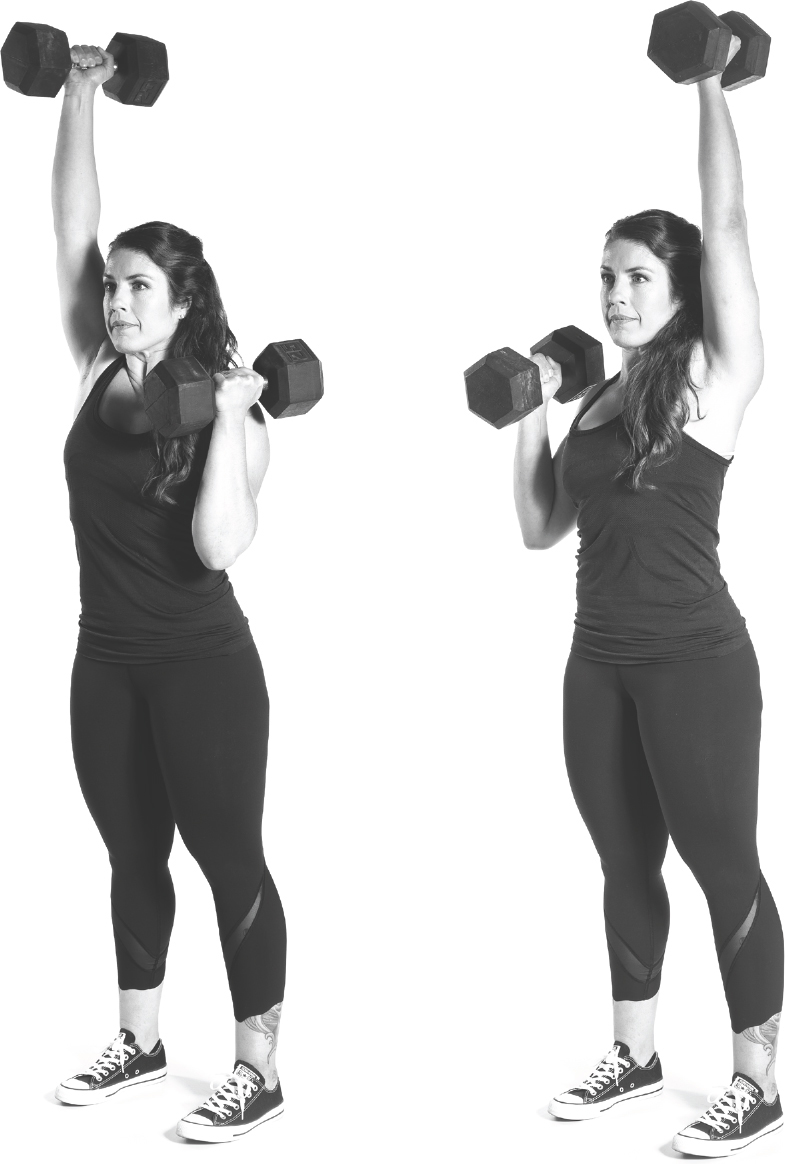
Stand with your feet under your hips and with dumbbells in both hands held at shoulder height, with your knuckles facing your shoulders. Engage your core, squeeze your butt, and keep your neck neutral as you actively push up through the shoulder to raise one dumbbell toward the ceiling. Keep your arm close to your head. Also, pull your ribs down instead of flaring them out. Lower the dumbbell and repeat the movements with the opposite arm.
Pro Tip
» To make it harder, press both dumbbells up at the same time or use a barbell.

ALTERNATING DUMBBELL ROWS—4 sets of 8 reps with each arm
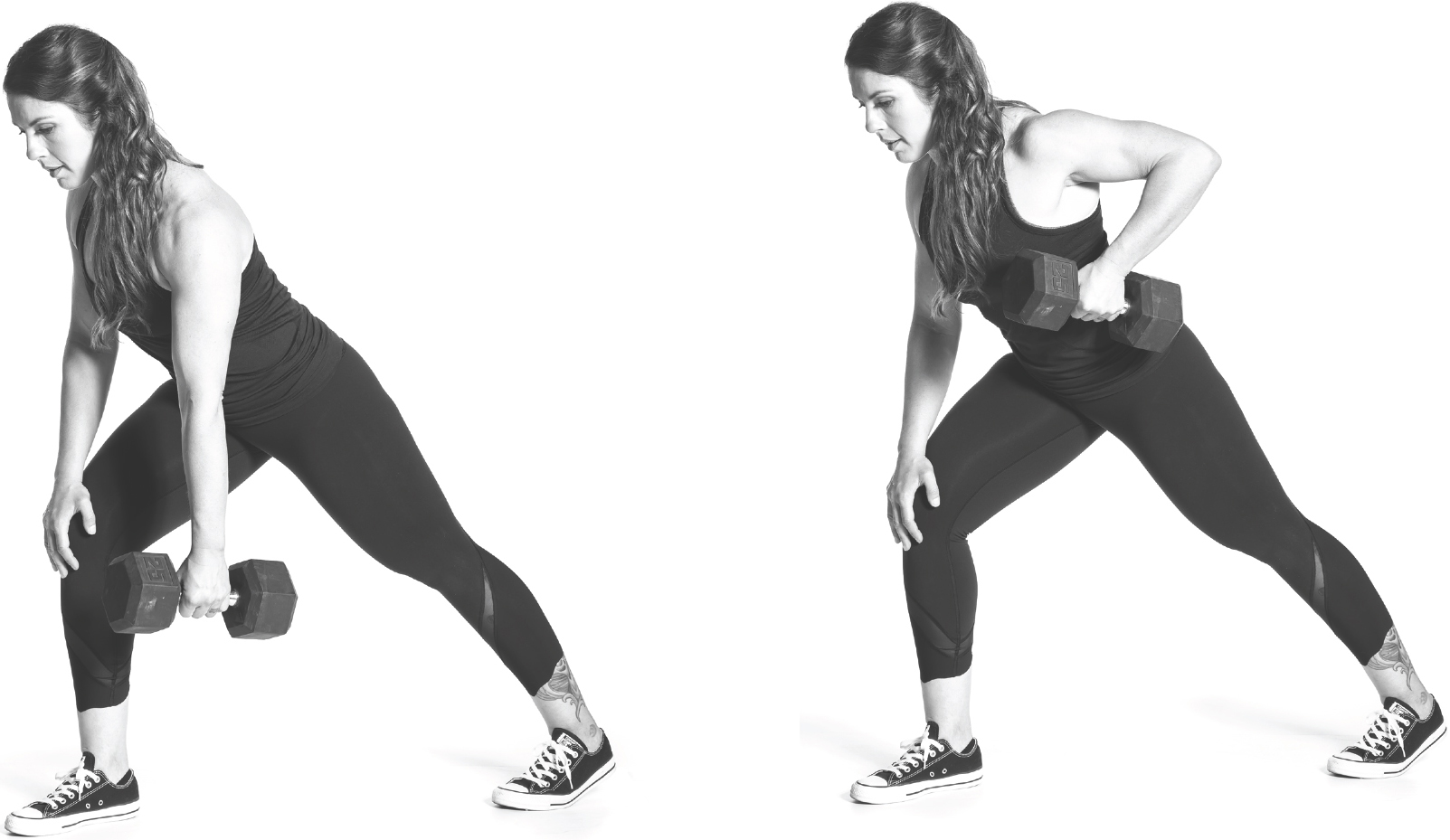
Holding a dumbbell in your left hand, to begin with, stand with your right foot forward in a partial lunge and your body from your left heel to the top of your head forming almost a straight line. Keep your abs engaged, your spine aligned, and your elbow close to your body as you pull the dumbbell up to your ribs, then lower it. You can rest your other hand on your knee or your leg for support. Repeat the movements on the opposite side.

MOUNTAIN CLIMBERS—3 sets of 12 reps with each leg

Get on the floor in the plank position, with your hands shoulder width apart. Engage your core as you quickly pull one knee toward your chest, just touching your foot to the floor before extending that leg back again. Repeat the movement with the opposite leg. Continue to alternate legs.
Pro Tip
» To make it harder, increase the pace.
LEVEL 2

BARBELL BACK SQUATS—3 sets of 2 at RPE 8
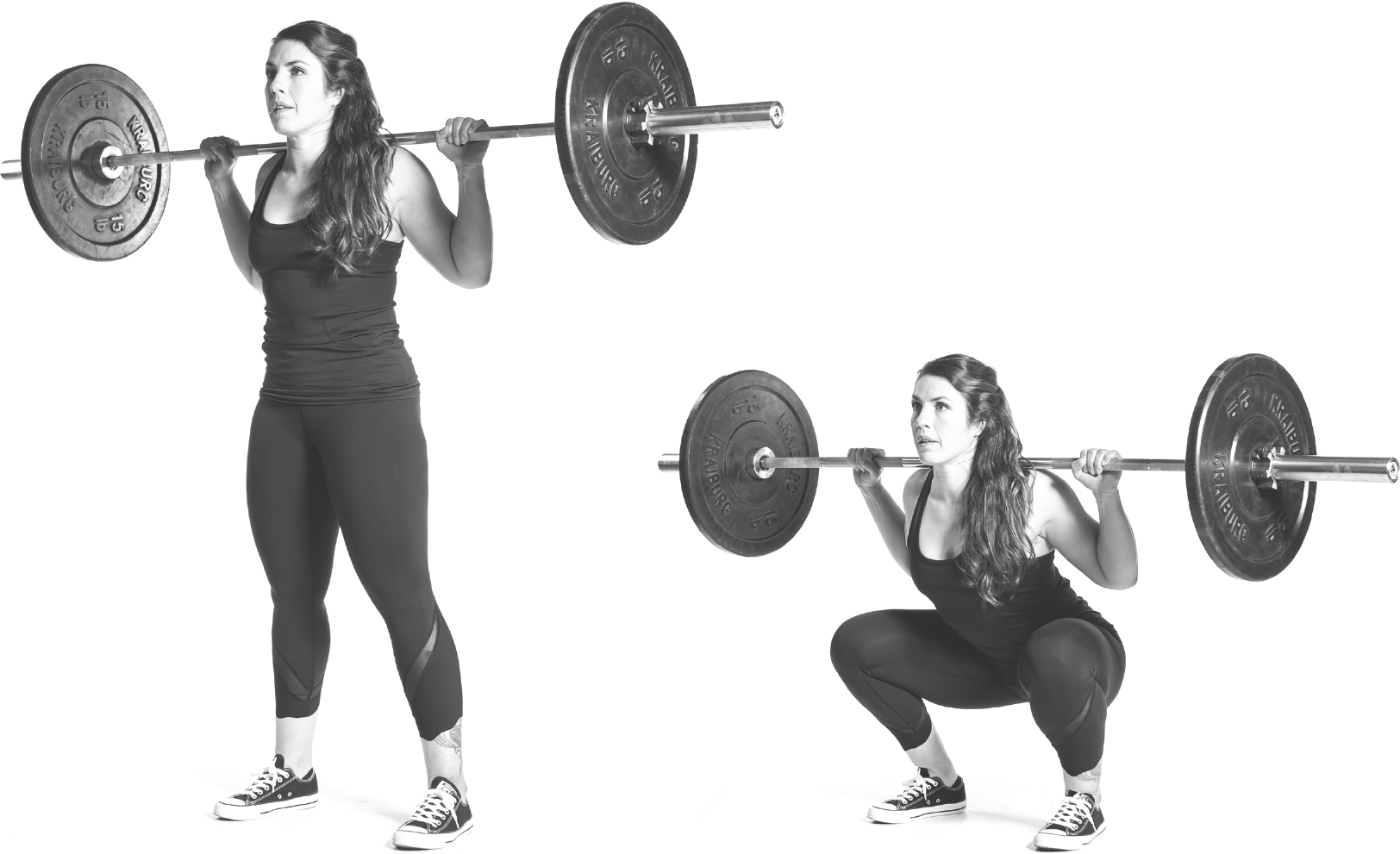
Stand with a barbell resting across the meaty back of your shoulders, called the trapezius muscles, and held in an overhand grip. Don’t let the barbell rest on your neck bones. Inhale, engage your core, squeeze your glutes, and hinge at the hip before bending your knees to lower your butt toward the floor until your thighs are parallel to the floor or slightly lower. Keep your neck neutral and your chest high, then return to the starting position, exhaling on the way up.

BARBELL POWER CLEANS—up to 3 sets of 1 rep at RPE 7+

Stand with your feet slightly wider than hip width apart and with a barbell on the floor in front of your feet. Hinge at the hips and grab the barbell overhand with your hands positioned just outside your hips. Lift it to your thighs, then push with your legs and jump as you bend your elbows to flip the bar up and shrug it to your shoulders. The power comes from your legs driving the bar up rather than pulling it with your arms. Stand in a partial squat with your knees slightly bent. Pause briefly, then return the bar to the floor.
Pro Tip
» To make it harder, use an unbalanced object like a sandbag, or receive the weight in a full squat clean.

PUSH-UPS—4 sets of the maximum reps you can do

Lie facedown on the floor and place your hands on the floor next to your body at about chest level, with your elbows close to your sides. Your body should look like an arrow if you could view it from above, not the letter T. Push your body up so that you’re on your hands and toes, keeping your body in a straight line. Don’t stick your butt up into the air or drop your butt too low. Bend your elbows to lower your chest toward the floor, and then push back up. As you push up, take a breath and keep your butt and core tight.
Pro Tip
» To make it harder, add weight on your back, or try clapping push-ups.

HOLLOW ROCKS—4 sets of 10 to 15 reps
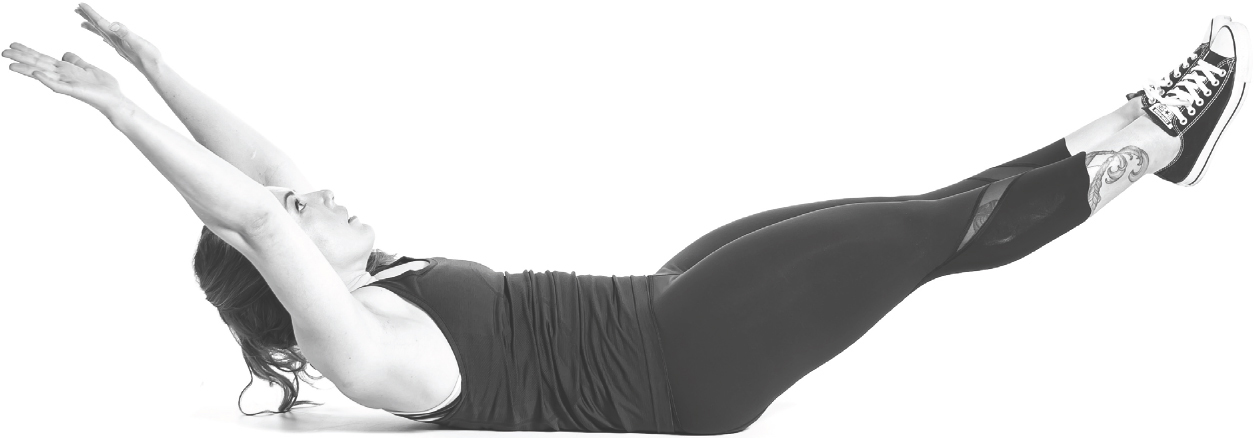
Lie on your back with your arms extended above your head. Engage your core and raise your legs and arms at the same time, pointing your toes and keeping your arms close to your ears. Press your lower back to the floor as you rock lightly back and forth, maintaining the same body position and breathing normally. Relax down into your starting position.
Pro Tip
» To make it harder, hang by your arms from a pull-up bar instead, squeeze your butt, brace your core, and pull your knees up toward your elbows, crunching your abs.
DAY 29: PURPOSE
Today we’ll pull back a bit to take a 30,000-foot view and talk about a big picture topic: purpose.
Some people associate purpose with living to a higher potential or to serve others in the world. When there’s misalignment between your purpose and what you actually do in the world, you’re likely to feel a drain on your energy. Sometimes it shows up as a lack of fulfillment with career. Other times, it’s a feeling of drifting aimlessly like a ship without a sail.
Perhaps one of the simplest ways to look at purpose is inspired by author Tony Schwartz. He succinctly defines purpose as what happens when your values meet your actions. A clear sense of purpose results when the two align. A lack of purpose results when they don’t.
Remember your Values Inventory Worksheet in the Pillar 4 chapter? Your values are what you hold to be true in life, the guiding principles you live by, and the things that are important to you. Some values are intrinsic, such as creativity and honesty. Some are extrinsic, like the need for recognition or status. And one type isn’t inherently better than the other, but most people find intrinsic values to be more satisfying and less fleeting. When what you do in the world—your actions—matches your values, you’re likely to feel a clear sense of purpose.
How to Look Outside Yourself
In the Core 4 program, you’ve done a lot of work on your internal landscape. Taking care of yourself and attending to your basic needs is very important. And in times of extra stress, I highly recommend my clients prioritize this kind of self-care. It’s not to be selfish or ignore your other responsibilities. Rather, it’s because you’ll have extra energy, patience, and joy when caring for others if you’ve taken care of yourself first.
When you’re more relaxed, your metaphorical blinders are taken off. Your perspective widens and you see solutions where previously there appeared to be none. When you’re stressed, however, you’re in blinders mode. Everything narrows. Time slips away too fast. That’s when it’s time to buckle down and take care of you.
Once you start filling your cup again, you’re better able to care for others.
Please don’t mistake what I’m saying. Serving others with energy you do not have is not sustainable. That would be like feeding the poor by maxing out your credit card. You’re spending money you don’t have, and it’s going to catch up with you in the end.
Instead, what if you round up on every debit card purchase you make for a year and put that money into a special account . . . then you donate what you’ve saved up? Think about building up enough extra energy so you can give of that surplus freely to others without dipping into your own “account.”
Service to others is one of the most fulfilling ways to connect with your purpose, but putting your health and wellness in jeopardy to do it might not be worth it in the end. Take care of you, then give to others to bolster your sense of purpose and community in ways that align with your values.
Day 29 Challenge: Complete the Values Inventory Worksheet
If you haven’t already, fill out the Values Inventory Worksheet and give some thought to what you came up with.
DAY 30: BUILD LASTING HABITS
Welcome to the last day! You learned on Day 28 that getting grateful is a powerful way to focus your attention on all the good stuff you’ve got in your life. Do it often enough and it becomes a habit. But what about your not-so-awesome habits?
All you have to do is type “break a habit” into Google, and you’ll get a staggering 46 million plus hits. The term “break a bad habit” has been repeated so much it’s practically fact. But is it?
In The Power of Habit, Charles Duhigg presents an incredibly useful way of understanding habits: they can’t be broken, but they can be worked around. Duhigg explains that once a habit develops, it’s there to stay, because you’ve created neural pathways in your brain that automate the behavior.
To deal with a habit you don’t want anymore, create a new habit in its place that will override the old one.
My client Melissa had a habit of drinking wine after dinner. At a certain point she decided it was time to take a break from wine. It was disrupting her sleep, and the empty calories each night weren’t helping her body composition goals.
Instead of just telling Melissa to stop drinking wine—which would likely result in a battle of willpower—we worked together to create a different habit that could take its place. She started off thinking she needed to drink something else to keep her hands busy. When I asked her to get clear about why she drank the wine, it wasn’t because she was hungry or thirsty or bored. It was to deal with the stress of the day. So Melissa came up with a new habit that worked better: writing in her journal.
There’s also no set amount of time it takes to create or replace a habit in the first place. It differs from person to person and habit to habit. The oft-repeated statement “It takes twenty-one days to form a new habit” is not supported by what happens in the real world. Sometimes it’s faster, sometimes slower.
Looking Deeper into Habits
To really understand your habits, it helps to look deeper and consider these questions:
Are there any cues that cause you to repeat the habit? For Melissa, it was the time of day—after dinner.
What do you get from repeating the habit? Does it provide escape from something boring or painful? Maybe it’s stimulating, providing energy or connection with another person. Melissa hypothesized that wine rewarded her with an escape from stress. She replaced her wine habit with a bath and journaling after dinner to cope with the stress of her day . . . and it became a lasting replacement for her glass of merlot.
To effectively build new habits in place of the old ones, you have to drill down to figure out what the reward is. And just because a new behavior seems promising on paper doesn’t mean it will stick when you try it out in the real world. That’s why you sometimes have to try again until you find a better behavior that sticks around until it becomes more automatic.
Day 30 Challenge: Journal About a Habit You Currently Have That You’d Like to Replace, plus Work Out
Identify the cues and benefits of a habit you’d like to change. Brainstorm a few new behaviors you could substitute for the old one. Over the course of the next week or two, try implementing the new behaviors. If something doesn’t stick, try again!
As always with this workout, the movements from last week make a dynamic warm-up. Complete all sets and reps of each movement before moving on to the next.
LEVEL 1

TURKISH GET-UPS—1 set of 5 reps on each side

Lie on the floor holding a dumbbell or kettlebell in your right hand, with your arm pointed straight up at the ceiling. Keep your eyes on the weight above you as you bend your right knee to bring your right foot flat onto the floor next to your hip. Engage your core as you press up onto your left elbow, then your left hand. Slide your left leg back between your left arm and right foot so that you’re kneeling on your left knee, then lift your left hand off the floor. Go slowly and find stability in each position. Continue to keep your eyes on the weight as you return to the starting position by reversing your movements.
Pro Tips
» To make it easier, do all the moves without a weight.
» To make it harder, after you lift your hand from the floor, fully stand up while again continuing to keep your eyes on the weight above you.

GOBLET SQUATS—4 sets of 12 reps

Stand with your feet slightly wider than hip width and hold a dumbbell or kettlebell in front of your chest. Inhale and engage your core as you hinge from your hips and bend your knees to lower your bottom toward the floor, keeping your feet in a comfortable squat stance with your thighs a little lower than parallel. Exhale as you return to the starting position.

SPLIT SQUATS—4 sets of 10 reps with each leg
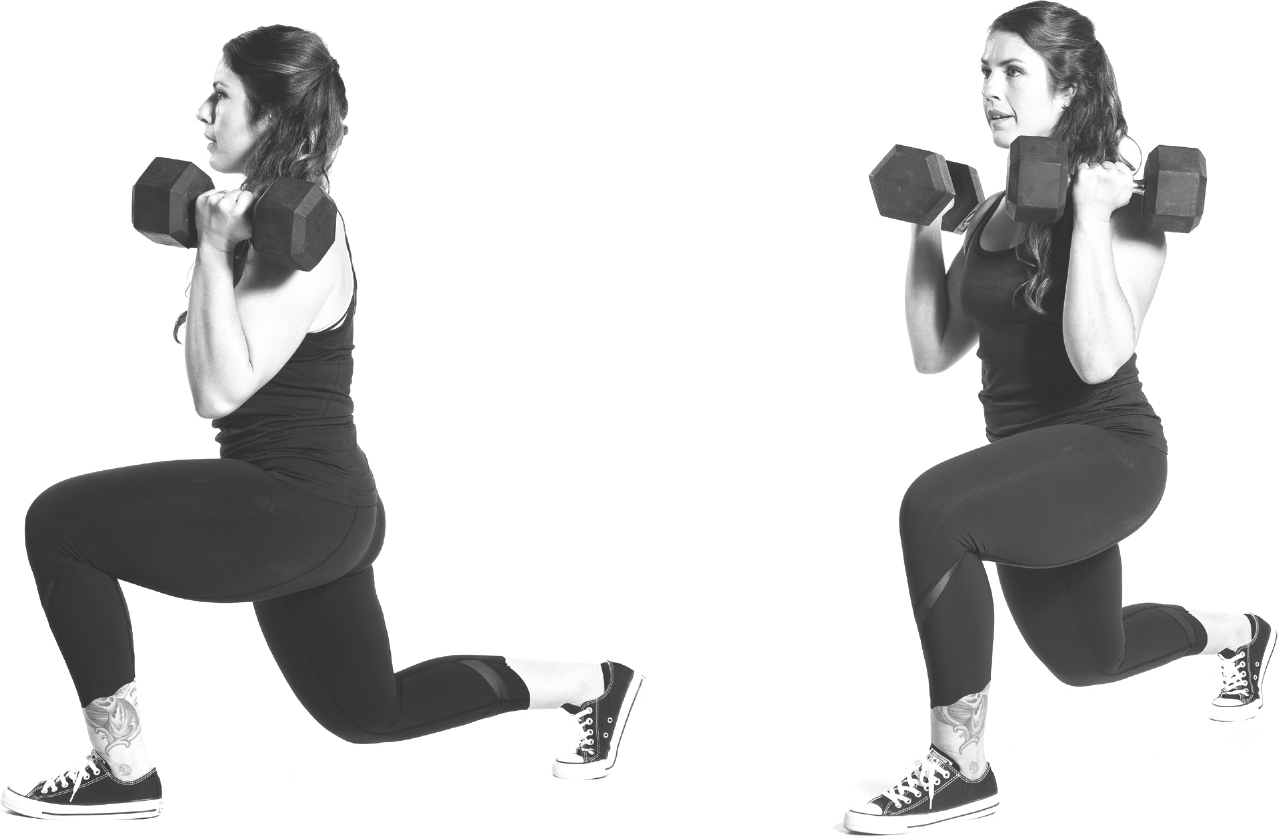
Stand with your feet under your hips and with dumbbells held at shoulder height. Step forward with your left leg into a lunge stance. Engage your core and gently lower your right knee toward the floor. Return to a standing position, then lower your right knee again. Do all reps on this leg before driving through your front foot, engaging your glutes, and returning to the starting position. Repeat with opposite leg positions.
Pro Tip
» To make it harder, place your back foot up on a bench (to do a Bulgarian split squat).

PUSH-UPS—3 sets of 10 reps

Lie facedown on the floor and place your hands on the floor next to your body at about chest level, with your elbows close to your sides. Your body should look like an arrow if you could view it from above, not the letter T. Push your body up so that you’re on your hands and toes, keeping your body in a straight line. Don’t stick your butt up into the air or drop your butt too low. Bend your elbows to lower your chest toward the floor, and then push back up. As you push up, take a breath and keep your butt and core tight.
Pro Tip
» To make it harder, add weight on your back, or try clapping push-ups.

HOLLOW ROCKS—4 sets of 10 to 15 reps

Lie on your back with your arms extended above your head. Engage your core and raise your legs and arms at the same time, pointing your toes and keeping your arms close to your ears. Press your lower back to the floor as you rock lightly back and forth, maintaining the same body position and breathing normally. Relax down into your starting position.
Pro Tip
» To make it harder, hang by your arms from a pull-up bar instead, squeeze your butt, brace your core, and pull your knees up toward your elbows, crunching your abs.
LEVEL 2

BARBELL DEADLIFTS—1 set of 3 reps at RPE 8

Stand with your feet under your hips with a barbell on the floor close to your shins. Hinge at the hips and grasp the barbell overhand with your hands positioned just outside your hips. Inhale, engage your core, squeeze your glutes, and push the floor away with your legs instead of lifting your back to raise the barbell. Keep your neck neutral and the barbell close to your body as you come to a standing position, exhaling on the way up. Be sure to keep your toes from lifting off the floor throughout the movement. Hinge forward at the hips, lower the weight to the floor, and return to the starting position.

BARBELL SHOULDER PRESSES—3 sets of 5 reps at RPE 7
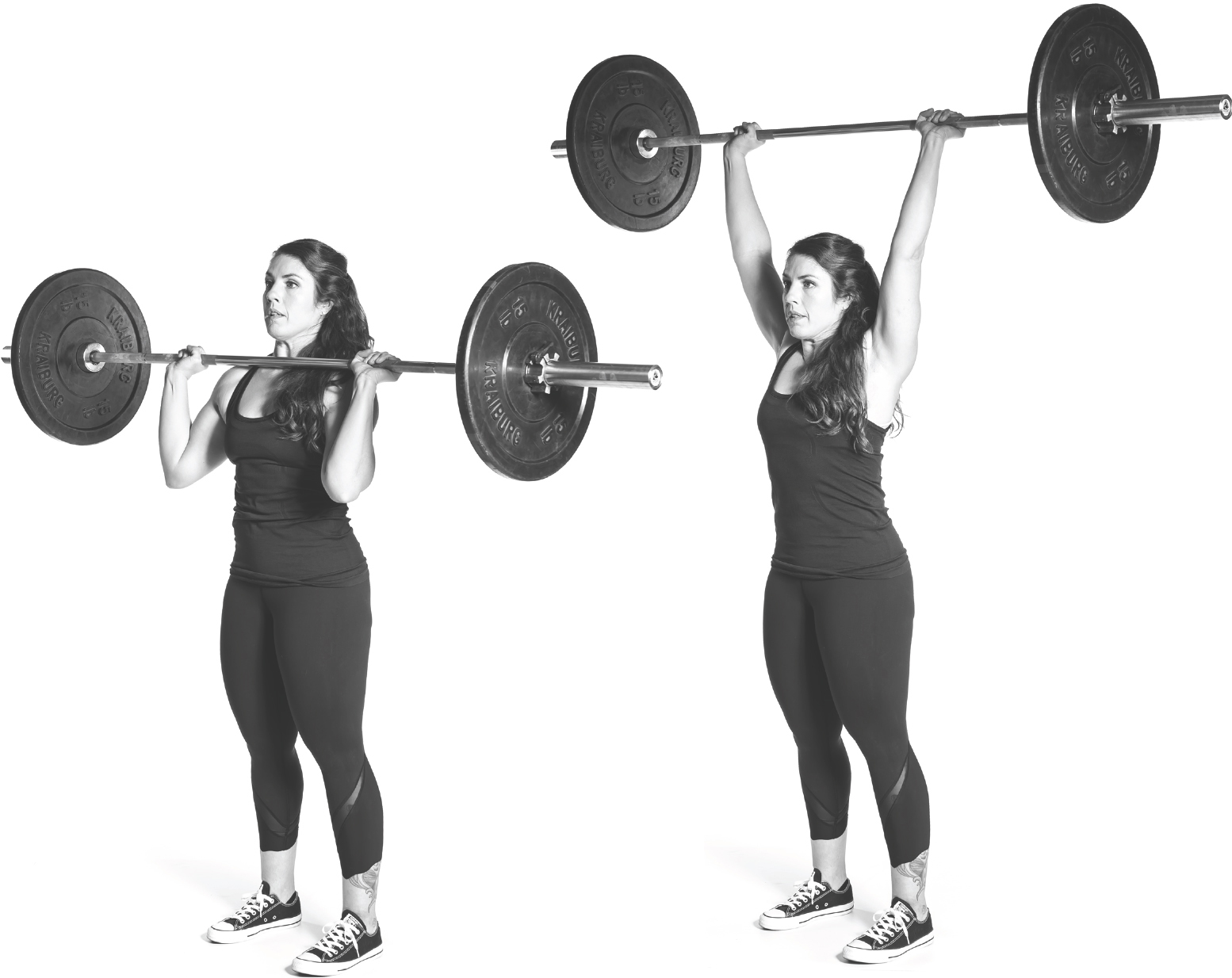
Stand with your feet under your hips and holding a barbell across the front of your shoulders with an overhand grip. Your hands should be slightly wider than shoulder width apart. Engage your core and press the barbell toward the ceiling. Maintain a neutral posture and pull your ribs down instead of flaring them out. Return to the starting position.

PULL-UPS—4 sets of 5 or more reps
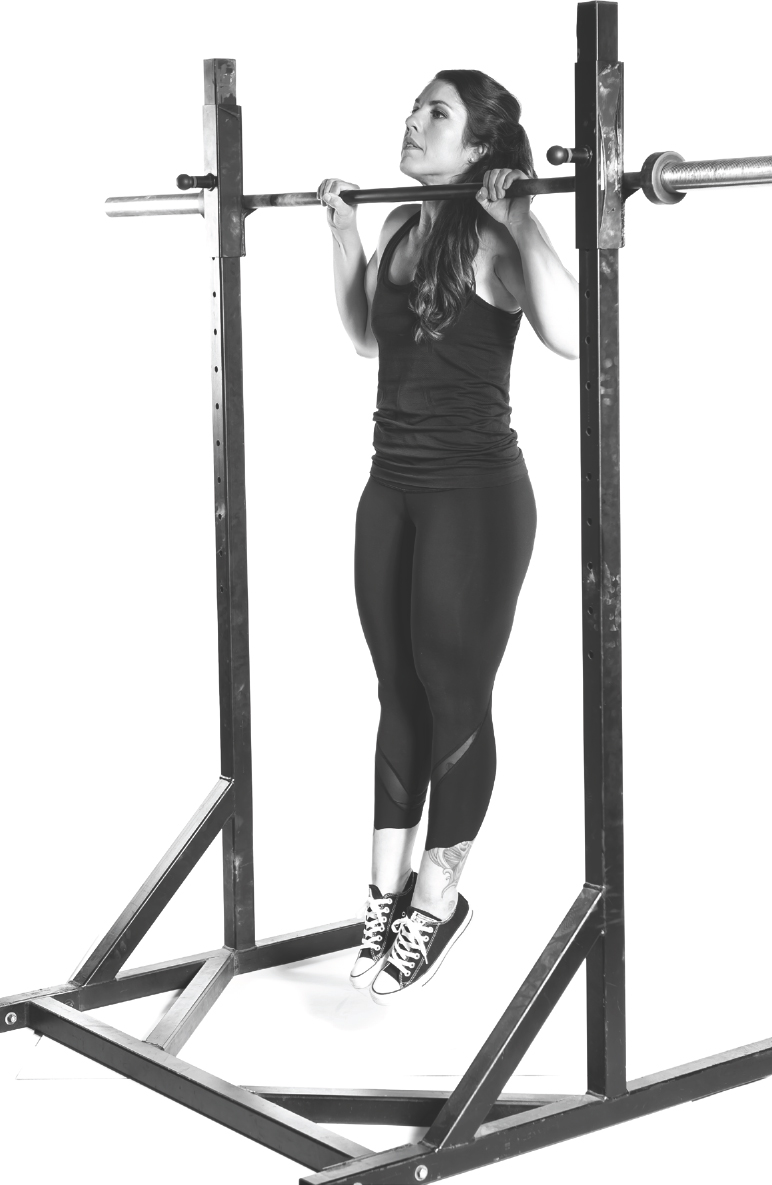
Stand under a pull-up bar with your hands gripping the bar underhand or overhand (your choice) and shoulder width apart. Your thumbs should be wrapped all the way around the bar. Inhale as you engage your core and pull your body up until your chin clears the bar. Keep your neck neutral—don’t crane your chin over the bar. Then lower back to the starting position with control to protect your shoulders.
Pro Tips
» To make it easier, secure a band around the bar and place your feet in it to reduce the amount of weight you’re pulling up. Or start at the top of the pull-up position and then lower yourself down instead of doing the complete rep.

TURKISH GET-UPS—1 set of 5 reps on each side

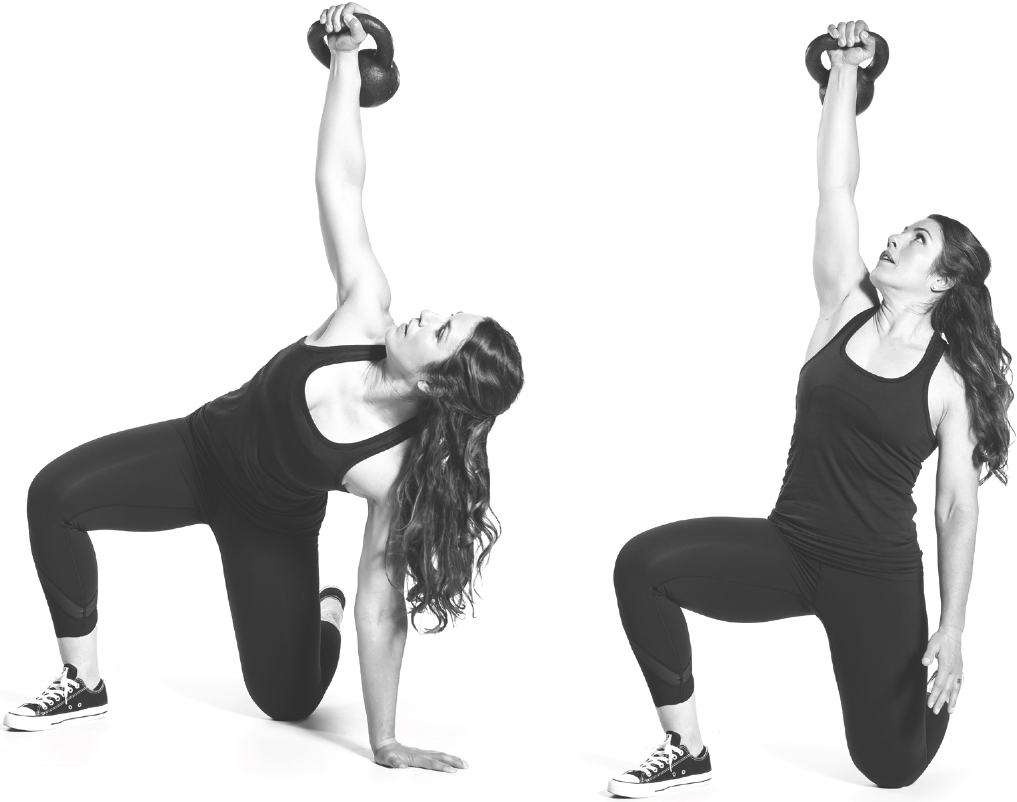
Lie on the floor holding a dumbbell or kettlebell in your right hand, with your arm pointed straight up at the ceiling. Keep your eyes on the weight above you as you bend your right knee to bring your right foot flat onto the floor next to your hip. Engage your core as you press up onto your left elbow, then your left hand. Slide your left leg back between your left arm and right foot so that you’re kneeling on your left knee, then lift your left hand off the floor. Continue to keep your eyes on the weight above you as you fully stand up. Go slowly and find stability in each position. Then return to the starting position by reversing your movements.
Pro Tip
» To make it easier, do all the moves without a weight, or practice the first half of the movements without involving the legs.